

How to Write a Customer Analysis for a Business Plan
- March 21, 2024
- Business Plan , How to Write

Understanding your customers is essential for any business striving for success. A customer analysis provides valuable insights into the demographics, preferences, behaviors, and needs of your target audience .
This guide will walk you through the process of writing a thorough customer analysis, enabling you to tailor your products, services, and marketing strategies to meet the needs of your customers effectively.
Define Your Target Audience
Begin by clearly defining your target audience : the specific group of people you aim to serve with your products or services.
Consider factors such as age, gender, income level, geographic location, and psychographic traits (e.g., lifestyle, values, interests). Understanding who your customers are is the first step in building a successful business strategy.
- Example for a Coffee Shop : Your target audience might include young professionals aged 25-40, living in urban areas, who value high-quality coffee and a relaxed atmosphere for socializing or remote work.
Gather Data on Your Customers
Next, gather data on your customers through various sources, including market research surveys, interviews, focus groups, and customer feedback.
Analyze both quantitative data (e.g., demographics, purchase history) and qualitative data (e.g., customer feedback, testimonials) to gain a holistic understanding of your customers’ needs and preferences.
- Example for a Coffee Shop : Conduct surveys or interviews with your target audience to gather insights into their coffee preferences, frequency of visits to coffee shops, and reasons for choosing one coffee shop over another.
Segment Your Customers
Segment your customers into distinct groups based on common characteristics or behaviors.
This segmentation allows you to tailor your marketing efforts and product offerings to better meet the specific needs of each segment. Common segmentation criteria include demographics, psychographics, behavior, and purchasing patterns.
- Example for a Coffee Shop : Segment your customers based on their coffee preferences (e.g., espresso lovers, latte enthusiasts), frequency of visits (e.g., daily customers, occasional visitors), and reasons for visiting (e.g., socializing, work meetings).
Analyze Customer Needs and Preferences
Analyze the needs, preferences, and pain points of each customer segment to identify opportunities for product or service improvement.
Consider factors such as price sensitivity, convenience, quality expectations, and brand loyalty. This analysis will help you tailor your offerings to better align with customer expectations.
- Example for a Coffee Shop : Analyze customer feedback to identify common preferences in coffee flavors, brewing methods, and food options. Use this information to adjust your menu offerings and pricing strategies accordingly.
Assess Customer Behavior
Examine how customers interact with your business at each stage of the buying process, from awareness to purchase and post-purchase.
Identify patterns in customer behavior, such as browsing habits, purchase frequency, and loyalty. This analysis will help you optimize the customer experience and maximize customer satisfaction and retention.
- Example for a Coffee Shop : Track customer traffic patterns, peak hours, and popular menu items to optimize staffing levels, inventory management, and promotional strategies.
Identify Growth Opportunities
Based on your customer analysis, identify growth opportunities for your business. This could involve expanding into new customer segments, introducing new products or services, or entering new geographic markets.
By understanding your customers’ needs and preferences, you can better position your business for long-term success.
- Example for a Coffee Shop : Identify opportunities to expand your customer base by offering specialty coffee subscriptions for remote workers or partnering with local businesses to host networking events.
Privacy Overview

How To Develop the Customer Analysis Section of Your Business Plan
What is the Customer Analysis in a Business Plan?
A customer analysis thoroughly examines who your customer is, why a customer chooses your products or services, and why a customer will return to buy your products or services again and again. A completed customer analysis will also serve as important information for lenders or investors who examine your business plan. It tells them that you thoroughly know who will buy your products or services and why.
Customer Analysis Methods
Choosing the right customer analysis method, or a combination of methods, is a crucial step in developing a comprehensive understanding of your target market. These methods offer insights into customer behavior, preferences, and buying patterns, enabling businesses to tailor their products, services, and marketing strategies effectively. Whether you opt for a single approach or integrate multiple techniques, the goal is to gather actionable data that supports informed decision-making and strategic planning for your business’s growth.
Surveys and Questionnaires
One of the most direct methods of customer analysis is through surveys and questionnaires. This approach allows businesses to gather qualitative and quantitative data directly from potential or existing customers about their preferences, buying habits, and direct customer feedback on products or services. Carefully designed questions can provide valuable insights into customer demographics, psychographics, and behavior. Digital tools and platforms can facilitate the distribution of surveys to a wide audience, allowing for a broad sample size that can lead to more accurate and actionable data.
Social Media Analysis
Social media platforms are a goldmine of customer data and sentiments. Analyzing social media interactions can provide real-time insights into how customers perceive your brand, what they expect, and their level of engagement with your products or services. Tools like sentiment analysis and social listening can help identify trends, monitor brand mentions, and understand the overall customer sentiment. This method is particularly useful for capturing the voice of the customer and adjusting marketing efforts accordingly.
Focus Groups
Focus groups offer a more in-depth method of customer analysis, allowing for detailed discussions and feedback on specific topics, products, or services. By bringing together a diverse group of customers, businesses can explore customers’ attitudes, perceptions, and reactions in a controlled environment. Although more resource-intensive than surveys, focus groups can provide nuanced insights into customer needs and preferences, often uncovering issues or opportunities not visible through other forms of analysis. The key to a successful focus group is careful selection of participants and structured facilitation to ensure open and honest feedback.
How To Write the Customer Analysis For Your Business
Below, we outline steps that will guide you through creating a customer analysis section that not only aligns with your business goals but also resonates with investors and stakeholders.
Develop Your Customer Persona
Understand their buying behaviors, conduct market research to identify current trends, research what the competition is doing, customer analysis examples.
To illustrate the depth and application of a thorough customer analysis, consider the following two examples. These samples will provide you with a framework to craft a customer analysis that resonates with both investors and your target audience.
Example #1 – Little Dreamers Boutique
Little Dreamers Boutique primarily targets parents, guardians, and gift-givers seeking high-quality, fashionable clothing and toys for children aged newborn to pre-teen. The boutique’s ideal customers are individuals who value unique, stylish, and sometimes eco-friendly options for children’s attire and playthings. Situated in the vibrant downtown area of Greenville, the boutique also attracts foot traffic from locals and visitors exploring the picturesque row of shops and cafes. The demographic is largely middle to upper-middle-class consumers who are willing to invest in premium products for the children in their lives. Secondary customers include grandparents and extended family members looking for special occasion gifts.
Customers of Little Dreamers Boutique are motivated by the desire to purchase unique, high-quality items that are not found in typical retail chains. They appreciate the curatorial eye behind the selection of local and international brands offered at the boutique. Purchasing behaviors are influenced by the appeal of giving children and recipients stylish, comfortable, and sometimes eco-conscious clothing and toys. Seasonal trends, special occasions, and the continuous need for children’s clothing due to growth spurts also drive buying behavior. The boutique’s atmosphere, customer service, and product quality encourage repeat business and word-of-mouth referrals.
The children’s clothing and toy market is increasingly moving towards sustainability and unique, boutique-style offerings. Parents and gift-givers today show a preference for organic materials, ethical production, and products that support local economies. Little Dreamers Boutique is well-positioned to capitalize on these trends, with its focus on eco-friendly toys and sustainable fashion. Additionally, the rise of ‘shop local’ movements provides a favorable environment for the boutique’s growth. Staying adaptive to digital trends, like social media marketing and online shopping, is crucial for reaching a wider audience and catering to changing shopping behaviors.
Competition for Little Dreamers Boutique comes from both local shops and larger retail chains. While larger retailers might offer lower prices due to mass production, they lack the unique selection, personal touch, and community feel of Little Dreamers. The boutique sets itself apart by curating a diverse range of styles and brands that cater to the specific tastes and values of its customer base. Online competitors present a challenge in convenience and variety but cannot match the tactile, personal shopping experience offered by Little Dreamers Boutique. The boutique’s dedication to customer experience and unique product offerings creates a competitive advantage that keeps customers returning.
Example #2 – HandyFix Solutions
HandyFix Solutions targets a wide array of customers within the Austin metro area and its surrounding neighborhoods. We focus on homeowners and small business owners in need of dependable, high-quality handyman and maintenance services. The primary customer base includes:
- Busy Professionals : Individuals with demanding work schedules who lack the time to perform household repairs or maintenance tasks. They value quick, efficient service that fits into their busy lifestyles.
- Families : Homes with children often require frequent maintenance and updates. Families seek reliable services that can handle a diverse range of tasks, from simple repairs to major renovations, ensuring a safe and comfortable living space.
- Elderly Homeowners : Older residents may struggle with the physical demands of home upkeep and prefer to trust a professional for their home maintenance needs. They seek reliable, respectful and patient service providers.
Customers of HandyFix Solutions are primarily motivated by the need for convenience, quality, and trustworthiness. They prefer a one-stop solution for their home maintenance needs that offers both minor repairs and more extensive renovation services. The company’s commitment to quality workmanship, flexible scheduling, and excellent customer service aligns with the desires of its target customers.
The growing trend towards DIY home improvement has influenced the handyman service market, with more homeowners willing to undertake small projects themselves. However, for larger, more complex tasks, or for those without the time or skills, HandyFix Solutions provides a valued service. Furthermore, the increasing number of aging homeowners contributes to the demand for home maintenance and modification services, presenting opportunities for HandyFix to cater to this demographic.
Competitively, HandyFix Solutions distinguishes itself from larger, generalized contractors and franchise handyman services with its local expertise, personalized customer service, and a broad service offering that caters to specific community needs. The company faces competition from other local handymen and national chains; nevertheless, its dedication to customer satisfaction and quality workmanship positions HandyFix as a preferred provider in the Austin area.
HandyFix Solutions has strategically positioned itself to meet the diverse needs of homeowners and small businesses in the Austin metro area. By focusing on high-quality service, reliability, and a broad range of offerings, HandyFix aims to cultivate long-term customer relationships and build a strong, loyal base within its target market.
A clear summary of your comprehensive findings in the customer analysis will go a long way toward demonstrating the value of your business. Moving through the checklists, adding research, listening to focus groups, and interpreting industry data will combine to form a customer analysis that holds a central position in the business plan. Whether used in the introduction of a new business or as an entrepreneur, the customer analysis indicates you know your customer very well.
Comments are closed.
Get the Free Business Plan Guide
Is your organization optimizing its potential on social?
- · Brandwatch Academy
- Forrester Wave
Brandwatch Consumer Research
Formerly the Falcon suite
Formerly Paladin
Published October 31 st 2023
Complete Guide on How to Conduct an Effective Customer and Segmentation Analysis
Follow this detailed guide to conducting customer analysis and segmentation and learn how to target your customers with the right messages.
The purpose of undertaking customer analysis as part of a business plan is to examine in-depth the consumers most likely to purchase your product or service. Brands can establish different groups of customers and the needs of those customers. By understanding what motivates them to purchase, brands can build their business around providing solutions to those needs.
So, how can we define customer analysis?
What is customer analysis, and why is it important?
Customer analysis is the process of examining, understanding, and developing in-depth knowledge about the consumers most likely to convert into customers by purchasing your product or service.
Customer analysis is a critical component of market research and business strategy. The customer analysis process involves systematically collecting and examining data and insights about a company's existing and potential customers.
This type of analysis aims to discover consumer purchase drivers and how an organization can effectively fill the gap with its product offerings.
The goal is to identify and segment different groups of customers based on their unique traits, motivations, and needs. Organizations can explore demographics, psychographics, interests, behaviors, and other characteristics that make up a customer profile or buyer persona.
What is a customer profile or buyer persona?
A customer profile (or buyer persona) is a dossier containing a detailed record of the ideal consumer interested in purchasing your product or service. Organizations use buyer personas to tailor their marketing strategies, product development, and sales efforts to better align with customer preferences and expectations.
How can brands benefit from doing customer analysis?
Insights from customer analysis can help companies enhance customer satisfaction, target the right audience with tailored messages, uncover market trends, and make informed decisions, ultimately driving business growth and success in a competitive marketplace.
Customer analysis empowers businesses to bridge the gap between what they offer and what their customers genuinely need, ensuring that products and services provide practical solutions to consumer pain points.
Stages of customer analysis
Customer analysis should move through three different stages.
- You first need to identify who your current customers are. The more detailed understanding you have of your customers, the better. This one group of customers should then be split into subgroups with similar traits and motivations. You can also identify target customers you are not yet reaching.
- Customer analysis must then show what the needs of these different customer groups are.
- You then need to work out what bridges these two, identifying how the company’s products meet the needs of each customer group. How do you provide solutions to their pain points?
What is a customer analysis model?
Any analysis should start with asking clarifying questions that can help establish the reason for the analysis and create a framework for evaluating the data.
The customer analysis model represents the framework marketers and insights professionals can follow when diving deeper into the customer data to surface consumer preferences and interests.
Researchers often cite the 5W and 6W models, which stand for the Who, What, When, Where, Why, and, lastly, Why not of the data.
This approach to analyzing customer data can help reveal not only who your target audience is and what they might be interested in but also what they dislike and the reasons behind it.
5 Key steps to conducting effective customer and segmentation analysis
To conduct effective customer and segmentation analysis, organizations should follow the following five key steps:
1. Identify and segment your existing customer base:
- Identify your current customers and gather as much detailed information as possible.
- Segment these customers into distinct groups with similar traits and motivations.
- Identify potential target customers you still need to reach
You might like
How to discover audience insights in minutes.
Learn how to leverage Brandwatch Social Panels for audience analysis.
2. Define segment criteria:
- Ensure that your segmentation criteria are measurable, observable, substantial, and financially justified (the effort and resources required to target and serve a particular customer segment are justified by the potential return on investment).
- Consider whether marketing messages can be tailored to each segment.
- Evaluate the size and accessibility of each segment to determine the focus.
3. Develop customer profiles and personas:
- Create detailed buyer personas that include background, demographics, communication preferences, and challenges.
- Gather qualitative data in the form of quotes to humanize the personas.
- Visualize a human behind your potential buyer rather than an abstract idea when crafting your personas.
4. Discover customer needs and pain points:
- Engage with customers through surveys, social media, and direct dialogs to understand their needs (e.g., create an open feedback loop or run Q/As on social).
- Analyze past customer actions and explore relevant online platforms like Quora, Reddit, and LinkedIn groups.
- Use social intelligence to monitor discussions and content shared within your persona groups.
5. Connect customer needs to your brand:
- Work with internal stakeholders to determine how your brand can meet the needs and solve the problems of each customer group.
- Emphasize solutions over features, focusing on making customers' lives easier.
- Apply these insights to marketing, sales, and product development to better align with customer expectations and drive business success.
Identify your customers
You can learn more about your customers in a variety of ways, and a mix of research methods will give you the most accurate results. It is best to gather as much information as possible and avoid thinking details are irrelevant. Details like age, gender, location, demographics, and psychographics are all important, but so are their interests, other brands they like, publications they read, and so on.
Talking to them and running a survey will be the best way of hearing about them in their own words, although that does come with biases. Reduce this by complementing that research with sales and CRM data and speaking to customer-facing employees. Once you have identified these groups, social data can elaborate your understanding by providing a more holistic view of the groups.
Your guide to learning about consumers online
Learn how social listening can inform your primary research objectives
It’s also worth considering at this stage whether or not the buyer and end-user are the same person. In a B2B setting, the buyer might hold budget responsibility but not actually use the service or product themselves.
In a B2C setting, there are several situations when a buyer might not be the end user; a toy water pistol or a diamond ring are both unlikely to be used by the purchaser.
Do customer segmentation in groups
You cannot undertake an accurate customer analysis without segmenting your audience into groups whose members are homogenous and distinct from other groups. Your segmentation criteria should be:
- Measurable : Your analysis should identify the size of a market segment so that you can decide to what extent efforts should be focused on the segment.
- Distinguishable : Observable differences that are clearly defined must exist in order to characterize segments.
- Substantial : The market needs to be large enough to justify segmenting, with each segment substantial enough to make it worthwhile.
- Financial : There will be additional costs when marketing to multiple, separate groups, so the predicted income must exceed these costs.
- Accessible : Your marketing messages should be accessible to each market segment. Different groups will respond better to different forms of advertising.
Develop a customer profile analysis
Use your data, segmentation criteria, and some educated guesswork to develop your buyer personas. It helps to have personas to visualize a human rather than aiming for an abstract idea.
Elements to include in a buyer persona include:
- Background and responsibilities , including job title, career path, and consumers’ primary job responsibilities.
- Demographics , including gender, age, income, family, and location.
- Communication : Which channels do they prefer? What is their demeanor? Do they have an assistant?
- Media and influencers : Which publications do they follow, and which individuals are leading the conversation in their world?
- Challenges vs proposition : The challenges they face in implementing their primary job goals and how your product or service can help them overcome those issues.
- Objections : Common reasons why this persona wouldn’t choose your product.
- Common language : What language should you use to appeal to their needs?
- Quotes : Adding some qualitative data in the form of quotes can really help to bring the personas to life and remind you there are real people behind these aggregated models.
Discover your customers’ needs
The next step in customer analysis is to get a good idea of what the customer’s needs are. By understanding their needs, several departments can gear their output towards answering these questions rather than taking an “If you build it, they will come” approach.
There are numerous ways to discover what your customers’ pain points are.
- The best way is to ask them. A survey is great if you can get enough responses, and online services like SurveyMonkey can keep the cost down.
- Consider the past actions of the group, such as the percentage that have purchased a similar product at some time in the past.
- Look at questions asked on Quora or Reddit .
- For B2B businesses, looking at job adverts for your target customers can give you an insight into their day-to-day work and problems.
- Join LinkedIn professional groups to get an insight into questions and discussions.
- Social intelligence can again help to understand the issues faced by customers. You can begin by building an audience of your personas and then monitor that group for questions asked, relevant content shared (such as how-to guides), and discussions.
How does your brand meet the needs of the customer?
Once you’ve done your research and outlined your different customer groups and their needs, you should connect the dots to your brand and identify how you meet those needs. This section of customer analysis should just be a matter of discussing and brainstorming with internal partners.
Solution-based answers should come out of this process. Instead of merely listing features, concentrate on showcasing how these features address the challenges your customers and prospects have. Always focus on benefits ahead of features.
Solving the problems that customers face on a daily basis will resonate with them much better than shouting about a shiny new feature. Focus on how you can make their lives easier and more enjoyable.
This will obviously be reflected in marketing, but these insights can help sales and product development as well, tightening your focus to better match your customer’s needs.
Ready to make your customer and segmentation analysis?
Systematically conducting a customer and segmentation analysis is not merely a recommended practice but essential for any business aiming to thrive in today's competitive landscape.
By understanding the core principles of customer analysis and following the five key steps to conducting an effective analysis outlined in this blog, you can unlock your brand’s true potential and foster lasting success.
The journey of customer analysis starts from analyzing your existing customers, mirroring buyer personas after them, and ultimately connecting the dots between your brand and the solutions you provide to address your potential customers’ pain points.
The insights from conducting a customer analysis are not just data; they are the compass that guides your marketing, sales, and product development efforts to better align with your customers’ needs.
Now it's your turn: How are you going to harness the power of customer analysis to drive business success in 2024?
Content Writer
Share this post
Brandwatch bulletin.
Offering up analysis and data on everything from the events of the day to the latest consumer trends. Subscribe to keep your finger on the world’s pulse.
New: Consumer Research
Harness the power of digital consumer intelligence.
Consumer Research gives you access to deep consumer insights from 100 million online sources and over 1.4 trillion posts.

More in marketing
The 65 social media terms and definitions to know.
By Emily Smith May 20
20 Social Media Holidays to Celebrate This May
By Yasmin Pierre Apr 10
The Ultimate Guide to Competitor Analysis
By Ksenia Newton Apr 5
How to Market Your Sustainability as a Brand in 2024
By Emily Smith Mar 18
We value your privacy
We use cookies to improve your experience and give you personalized content. Do you agree to our cookie policy?
By using our site you agree to our use of cookies — I Agree
Falcon.io is now part of Brandwatch. You're in the right place!
Existing customer? Log in to access your existing Falcon products and data via the login menu on the top right of the page. New customer? You'll find the former Falcon products under 'Social Media Management' if you go to 'Our Suite' in the navigation.
Paladin is now Influence. You're in the right place!
Brandwatch acquired Paladin in March 2022. It's now called Influence, which is part of Brandwatch's Social Media Management solution. Want to access your Paladin account? Use the login menu at the top right corner.
How to Conduct An Effective Customer Analysis in 8 Steps
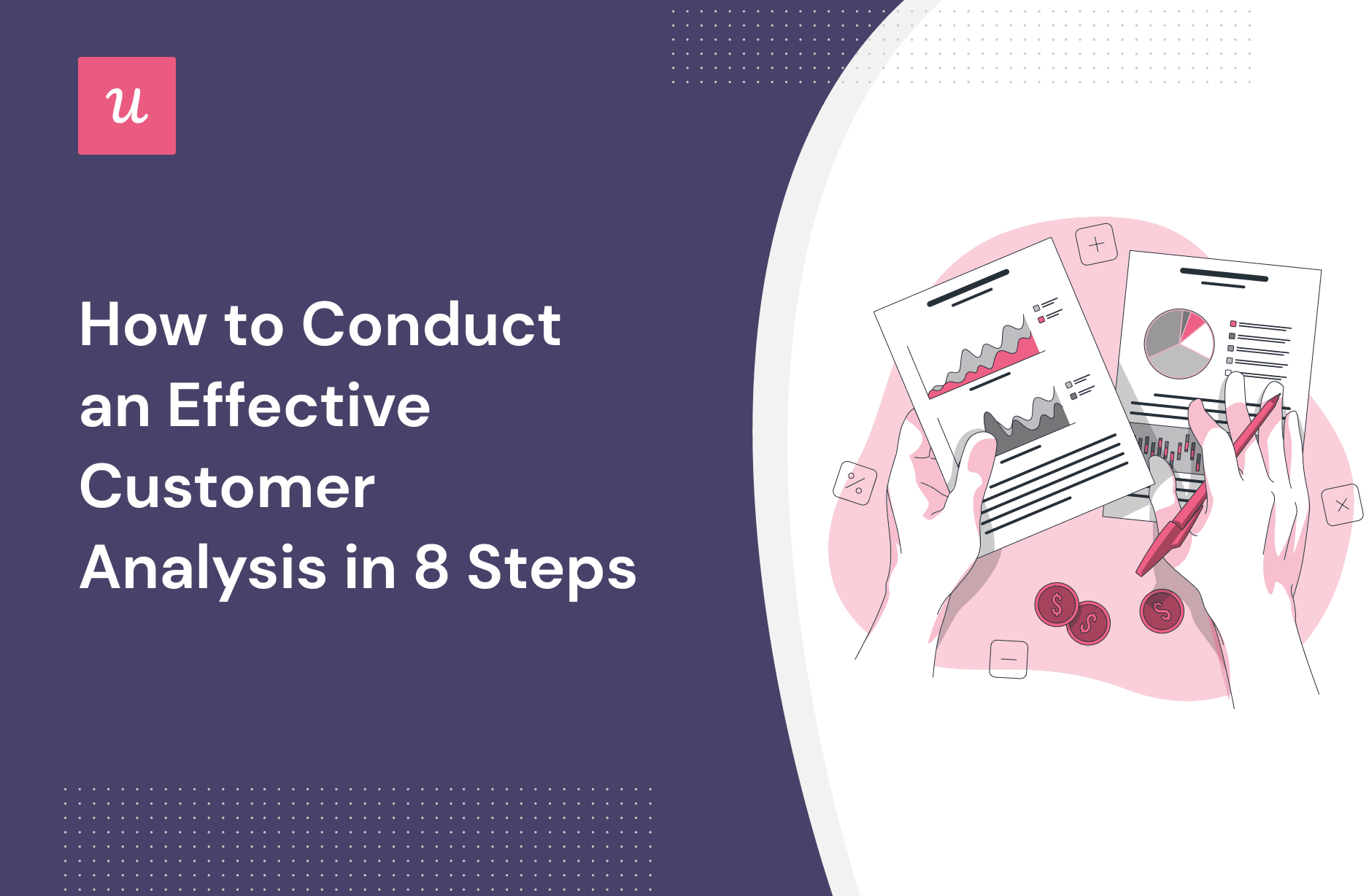
Effective customer analysis is the key to business success.
Understanding customers’ unique needs and expectations allow companies to better meet these needs. From marketing campaigns to onboarding programs, catering your product experiences to your customers improves satisfaction and retention rates.
Let’s take a closer look at what customer analysis is, its benefits, and how to get started.
- Customer analysis is the act of researching and analyzing customers to gather a complete profile of them and their behavior.
- Customer analysis is important because it helps you create a personalized marketing strategy , reduces churn and increases retention , helps you make smarter product improvements , and helps you identify your most valuable customers (your target market).
- To get started with customer analysis, start by structuring your existing customer base. Organize your customers into customer segments that share common characteristics.
- Then, collect direct customer feedback with in-app surveys . You can use CES , CSAT , and NPS surveys across the entire customer journey.
- Gather insights about your customers from internal teams. Every department likely has unique insights into customers based on their interactions with them. Share customer insights across departments so you don’t miss out on critical information.
- Leverage product analytics to do a customer behavior analysis and get a better understanding of how customers interact with your product.
- Perform social listening on social media and review sites to see an unfiltered look at what customers are saying about your brand.
- After completing your customer analysis, create user personas based on real customer traits. Buyer personas are great to turn to when planning your marketing campaigns or when you want to make product improvements.
- Build a customer journey map to make sure you’re hitting all the touchpoints and understanding how customers engage with your brand at every moment.
- The two top customer analysis tools of our choice are Semrush and Userpilot.
- With Userpilot , you can analyze customer behavior, run surveys, and create customer segments. Then you can build in-app product experiences to improve customer loyalty and satisfaction.
- With Semrush, you can see what marketing channels your website visitors come from (so you can prioritize the best channels). You can then build segments and create user personas.
What is customer analysis?
Customer analysis is the research you do to understand your target market and your customer base. Analyzing customers helps you build more in-depth and accurate customer profiles so you can meet their needs better.
Why is customer analysis important?
Here are the four main reasons why customer analysis is essential:
Create a personalized marketing strategy
Customer analysis helps you optimize your marketing campaigns .
You can then build a more informed marketing plan that engages customers in their preferred channel, with an impactful message, at the right time.
Reduce churn and increase customer retention
Customers churn because products don’t fulfill their expectations.
By understanding their challenges and pain points better, you can tailor your product, training, and experiences to their specific needs and retain them .
Make smarter product improvements
Customer analysis helps you make more informed product decisions. You’ll be able to create new features or make product improvements that will give customers the most value.
Take a look at your product analytics to see how current customers are using the product – are they using certain features more or less?
Observing customer behavior will help you determine what features customers find most useful and what areas may need improvement to increase usage.
I dentify your most valuable customers
With customer analysis, you can pinpoint exactly who your superstar customers are.
This will help determine which market segments to prioritize and how much effort to put into each one. Look at the type of people who have spent the most or stayed with you the longest – these are the ones with the highest customer lifetime value . Do they represent a certain demographic?
Focus on keeping those customers happy and acquiring more like them. They’re an ideal customer and catering to them will lead to faster productivity growth.
How to conduct a customer analysis
Try these nine strategies to conduct a customer analysis:
Structure your existing customer base
You should start the customer analysis process by identifying your potential customers and defining their specific characteristics.
The customer database is a great place for established businesses to begin gathering the above data. Most likely, you already have plenty of data, but you might need to structure it to make sense of it.
To do this, you need to divide your customer database into groups based on similar characteristics. This process of dividing up data is called segmentation .
There are lots of categories you can use to segment customers , including:
- Demographic (age, education, gender, etc.)
- Geographic location (countries, cities, urban or rural areas)
- Behavioral profile (how they interact with your product)
- Company size
- Psychographic (their challenges, goals, values, interests, etc.)
By understanding customer preferences through careful segmentation, companies can deliver targeted experiences, increase conversion rates and retain more customers in the long run.
Identify the needs of your customers
Through customer analysis, you can figure out what pain points you’re solving. Customers turn to your brand because they have a goal and they see you as the potential solution.
Doing this will help you to better understand how to create a post-purchase experience that promotes loyalty.
Collect direct customer feedback with in-app surveys
In-app surveys are one of the most commonly used and effective methods of collecting quantitative and qualitative data from your customers.
You can use different types of surveys at different touchpoints, such as customer effort score (CES), customer satisfaction (CSAT), and net promoter score (NPS) surveys.
Surveys that use both quantitative and qualitative methods give the most well-rounded insights. For example, you collect quantitative data with an NPS survey that asks customers to score how likely they are to recommend your product to a friend or colleague.
After collecting their response, you can trigger a follow-up open-ended question to get more context around their answer.

Invite your customers to one-on-one interviews
An interview can be a great way to empathize with your users as it provides insight into their values, perceptions, and experiences. In these discussions, you are free to ask specific questions while remaining open to participants’ viewpoints.
The advantages of interviews over other methods are they less time than some other user research methods and it’s easier to ask follow-up questions for more detail and accuracy.
You can invite your users to an interview using different in-app messages, such as slideouts.
Make sure to practice gratitude and incentivize them with a small reward , like a gift card.

Gather insights about your customers from internal teams
Businesses often have different departments, each with a different perspective on their customers’ needs . The insights you can gain about your customers from your internal teams can be extremely beneficial for developing a comprehensive view of them.
While sales teams may have a better understanding of customer needs, marketing teams may understand how customers respond to different content or visual stimuli. Meanwhile, Account Management and Customer Success teams may understand the customer’s day-to-day needs even better.
By leveraging all the available insights from across multiple departments, companies can capture a deeper understanding of their target audience and develop better strategies and provide quality experiences that generate growth.
Leverage product analytics
Lean into product usage data to understand customer behavior.
You can get insights into data such as:
- What features do customers use the most and the least
- Which paths do users take and how they navigate inside your product
- What links or call-to-actions users clicked
- What in-app messages have they already been exposed to

How do you collect product usage data ? One way is to use a product analytics tool to tag your UI patterns to see how customers interact with them.
Perform social listening
Keep an eye on public sources – customers often share their honest opinions about your brand on social media and review sites.
Social media: People tend to post on social media (unfiltered) when they have a strong opinion about something, good or bad. Monitor your tagged and untagged mentions on social media channels like Twitter, Facebook, LinkedIn, and Reddit to keep tabs on what people really think.
Review sites: Keep an eye on software review sites, like G2 and Capterra, to see what customer sentiment is like for your brand. Are the reviews overwhelmingly positive or not? What are common complaints? What do people appreciate the most about your product or service?

Social listening gives you a level of honest feedback that you wouldn’t be able to gather otherwise.
Create user and buyer personas
Once you have defined your target audience and identified the types of customers you wish to target, it’s time to start thinking about customer personas . Personas are fictionalized representations of your average customers, gathered and analyzed from all available data points.
Personas should contain enough details to represent the demographic you’re targeting, such as age, gender, occupation, income, location, and interests. Additionally, consider how your customers usually interact with your company and how they prefer to be contacted – e.g., by email or social media.
It is then possible to conduct more research on each persona – such as finding out what makes them tick, and what content they are most likely to engage with – to provide more innovative campaigns that target each segment directly.
Consider creating more than one buyer persona, as different customers will buy your products for different reasons.
Here’s an example of a user persona we created at Userpilot:

- UX Designer
- B2B SaaS with 11-50 employees
- Has found product-market fit
- They’re looking to automate onboarding
Team collaboration:
- Part of UI/UX team
- Collaborates with Product Marketing Manager
- Collaborates with UI designers and developers
Jobs to be done:
- User research to identify the needs of who they are designing for
- Prototyping and user testing to improve UX before launching
- Continuously iterate on solutions to make the product easy to use
Pains/challenges:
- Tapping into feedback collected by other departments, such as Marketing
- Identifying friction points in the user journey due to a lack of product analytics insights
- Hard to document and analyze qualitative data from surveys
Gains of using a Product Growth Platform:
- Build microsurveys to identify users’ needs and share the same data with multiple departments, using one platform only
- Goal tracking at each stage of the journey to help identify drop-off points in the journey
- Tag NPS surveys responses to easily identify patterns of what’s blocking the users from achieving their goals
A solid buyer persona profile can help the entire team better connect with customers and build a better product.
Build a customer journey map
Essentially, a journey map shows all the touchpoints and interactions that a customer must go through to reach their goal.
Considering that customers behave differently at each stage of the buyer’s journey, a customer journey map can help connect the dots and uncover the factors that determine whether their experience is positive.
Every persona should have its own customer journey map. The map will help you identify how to attract, engage, convert, and upsell specific personas and segments based on their challenges, questions, preferred platforms, and types of content.

Best tools for customer analysis
Here are the top two customer analysis tools to help you easily gather data and act on it:
Userpilot is a product growth platform that helps you improve product engagement and retain more customers.
They have multiple high-value features like event tracking, feature tagging, in-app flow builders, and more. As for customer analysis, with Userpilot you can run in-app surveys, track product behavior, tag UI elements, and create user segments based on customer data.

Then, you can put your insights into action by creating in-app product experiences that help boost your growth metrics.
Create contextual customer experiences using UI patterns, such as modals, tooltips, and banners.

Semrush is an all-in-one SEO, content marketing, competitor research, and social media marketing platform.
It’s an excellent tool for customer analysis since it shows you what channels your website visitors come from. Semrush is also as a template for categorizing your data to create user personas .
Also, Semrush Brand Monitoring can help you keep track of all mentions of your brand and product or service in real-time.

Customer analysis helps you increase profits, get more for your marketing efforts, and connect with your target customers.
Want to get started with customer analysis? Get a Userpilot Demo and see how you can do customer segmentation analysis and build in-app product experiences, code-free.
Leave a comment Cancel reply
Save my name, email, and website in this browser for the next time I comment.

Get The Insights!
The fastest way to learn about Product Growth,Management & Trends.
The coolest way to learn about Product Growth, Management & Trends. Delivered fresh to your inbox, weekly.
The fastest way to learn about Product Growth, Management & Trends.
You might also be interested in ...

Crafting the Customer Analysis in Business Plan: A Comprehensive Guide
In today’s competitive business environment, understanding your customers is the key to success. Customer analysis in business plans plays a crucial role in driving business growth and providing a competitive edge.
Imagine unlocking the hidden potential within your customer base, tailoring marketing strategies, and developing products that resonate with their needs and preferences. This comprehensive guide will explore the ins and outs of customer analysis in a business plan and how to leverage it for maximum impact on your business.
Short Summary
- Customer analysis is an essential part of any business plan, allowing businesses to understand their target customers and create tailored products/services.
- It involves identifying a market, assessing demographics & analyzing customer behavior in order to inform marketing strategies.
- Utilizing insights from customer analysis can help optimize marketing campaigns & product offerings for maximum return on investment.
The Essence of Customer Analysis
Customer analysis is an essential element of any business plan, emphasizing the comprehension of target customers, their requirements, and how your product or service fulfills those requirements. By performing customer analysis, businesses can better tailor their products and services to their target audience , ultimately leading to increased sales and a thriving business.
Understanding the needs of your target customers is key to success. Knowing who your customers are

Purpose of Customer Analysis
The primary objective of customer analysis is to recognize potential customers, prioritize customer segments, and provide guidance for marketing and product development strategies. Understanding your customers’ wants, needs, pain points, and objectives is crucial to creating targeted marketing campaigns and product offerings that resonate with them.
By closely monitoring customer feedback and support requests (Voice of Customer analysis), businesses can gain insight into customer pain points and preferences and even discover unexpected uses for their products.
Key Components of Customer Analysis
The essential elements of customer analysis encompass target market identification, demographic analysis, and behavioral analysis. Demographic analysis provides insights into factors such as age, income, and location, which can be used to create targeted marketing strategies.
Behavioral analysis, on the other hand, entails comprehending the customer’s decision-making process for the purchase, including the steps taken, information sources consulted, and who has the authority to make the final decision. By understanding these components, businesses can better cater to their customer’s needs and preferences, ultimately leading to success.
Conducting an Effective Customer Analysis
An effective customer analysis involves a thorough research process that focuses on customer pain points, goals, and insights on what influences their buying decisions. This process begins with identifying your target market, which is crucial in ensuring a successful business.
By analyzing customer demographics and examining customer behavior and purchasing patterns, businesses can tailor their marketing strategies and product offerings to address the specific needs and preferences of their target customers.
Identifying Your Target Market
Identifying your target market is the first step in conducting a comprehensive customer analysis. By precisely defining the target customer your company is serving, you can focus your marketing efforts and resources on the most profitable customer segments.
Small businesses with 10 to 50 employees located in large metropolitan cities on the West Coast can benefit from having a business plan. This plan should provide clear guidance and instructions for the successful execution of tasks, including target market analysis.
With a clear understanding of your target market, you’ll be better equipped to develop a targeted marketing strategy that resonates with your audience and drives sales.
Analyzing Customer Demographics
Analyzing customer demographics is crucial for tailoring marketing strategies to specific customer groups. By examining your current customer base, you can determine which demographics to focus on for future marketing efforts. Demographic information, such as:
- education levels
A comprehensive view of the messaging that is most likely to appeal to customers and the marketing channels that are most effective in reaching them can be achieved when customers seek multiple bids, as it provides valuable insights into their preferences and decision-making process.
By constructing a marketing strategy around the types of people who have already made a purchase, you can maximize the return on investment of your marketing budget.
Examining Customer Behavior and Purchasing Patterns
Analyzing customer behavior and purchasing patterns can yield valuable insights through customer behavior analysis. By monitoring customer interactions with your products and services, such as website visits, purchases, and customer reviews, you can identify customer needs and preferences and devise strategies to enhance customer retention and loyalty.
Additionally, understanding the drivers of customer decision-making is crucial for creating targeted marketing campaigns and product offerings that resonate with your target audience.
Utilizing Customer Analysis Results
Customer analysis results can be leveraged to enhance marketing strategies, drive product development and innovation, and strengthen customer retention and loyalty. By recognizing customer feedback and customer support requests, businesses can acquire advantageous insights into customer behavior and preferences, which can be utilized to provide direction to marketing and product development strategies.
In this section, we will explore how customer analysis results can be utilized to improve various aspects of your business.
Enhancing Marketing Strategies
Customer analysis results, including customer segmentation analysis, can inform targeted marketing strategies that lead to increased sales and revenue. By leveraging insights from customer demographics and behavior, businesses can create personalized marketing campaigns that resonate with their target audience. For example, a company catering to young professionals may focus its marketing efforts on social media platforms, while a company targeting older adults may prioritize direct mail or email campaigns.
By tailoring marketing strategies based on customer analysis, businesses can optimize their marketing efforts and achieve greater success.
Driving Product Development and Innovation
Insights from customer analysis can guide product development and innovation, ensuring that products and services meet customer needs and preferences. By understanding customer pain points and objectives, businesses can create new products and services that address these needs, resulting in increased customer satisfaction and loyalty.
Additionally, existing customer feedback can be utilized to refine existing products and services, making them more appealing to the target audience and driving business growth .
Strengthening Customer Retention and Loyalty
Understanding customer needs and preferences through customer analysis can help businesses improve customer retention and loyalty. By tailoring products and services to the specific needs and preferences of your target audience, you can enhance customer satisfaction and encourage repeat business.
Furthermore, by identifying gaps in the customer experience and optimizing touchpoints, businesses can improve the overall customer journey and nurture long-lasting relationships with their customers.
Tools and Techniques for Customer Analysis
To effectively conduct customer analysis, businesses can employ various tools and techniques, including data collection and analysis, creating buyer personas, and customer journey mapping. These methods enable businesses to gain a deeper understanding of their customers and make informed decisions regarding their products, services, and promotional activities.
In this section, we will explore the different tools and techniques that can be used in customer analysis.
Data Collection and Analysis
Data collection and analysis play a critical role in customer analysis, as they involve gathering information on customer interactions, demographics, and purchasing patterns. Businesses can utilize various methods for data collection, such as surveys, focus groups, and interviews, as well as analytics tools to track customer behavior online.
By analyzing this data through market research, businesses can identify trends, patterns, and areas for improvement, ultimately informing their marketing strategies and product development efforts.
Creating Buyer Personas
Creating buyer personas is an essential technique in customer analysis, as it helps businesses visualize their ideal customers and tailor marketing and product development strategies accordingly.
Buyer personas are fictional representations of major customer segments, taking into account factors such as:
- demographics
- professional status
- purchasing habits
By developing accurate and detailed buyer personas, businesses can ensure that their marketing campaigns and product offerings resonate with their target audience, leading to increased sales and customer loyalty.

Customer Journey Mapping
Customer journey mapping is an invaluable tool in customer analysis, as it enables businesses to identify gaps in the customer experience and optimize touchpoints to improve customer satisfaction and loyalty. A customer journey map is a visual representation of the stages a customer goes through when interacting with a business, from initial awareness to loyalty.
By understanding the customer journey and identifying areas for improvement, businesses can enhance the overall customer experience and nurture long-lasting relationships with their customers.
Case Study: Successful Customer Analysis in Action
A prime example of successful customer analysis in action is the Buxton case study. Buxton, a leading provider of customer analytics and consulting services, utilized customer analysis techniques to help businesses expand, grow, and market themselves more efficiently. Through a combination of data collection, buyer persona creation, and customer journey mapping, Buxton was able to gain a deep understanding of their client’s customers and develop targeted marketing campaigns that resonated with their audience.
As a result, their current customers experienced increased sales, customer loyalty, and overall business growth and success.
In conclusion, customer analysis is a powerful tool that can drive business growth and success by helping companies understand their target customers, tailor their marketing strategies, and develop products and services that meet customer needs and preferences.
By utilizing tools and techniques such as data collection and analysis, buyer persona creation, and customer journey mapping, businesses can gain valuable insights into their customers and make informed decisions that lead to increased sales, customer loyalty, and overall business success. Don’t miss out on the opportunity to unlock your business’s full potential – start conducting customer analysis today and reap the rewards.
Frequently Asked Questions
What is a customer analysis in a business plan.
A customer analysis is an essential part of a business plan, which identifies target customers and outlines how a product or service meets their needs.
It helps businesses understand their customers better, so they can create marketing strategies that are tailored to their target audience. It also helps them identify potential opportunities and threats in the market.
By understanding their customers, businesses can better serve their customers.
What is an example of customer analysis?
Customer analysis involves understanding consumers’ behaviors through observation and measurement of analytics, analyzing brand recognition and awareness, understanding how customers feel about the competition, and testing different customer acquisition approaches.
This process helps businesses better understand their target audience and develop strategies to reach them. It also helps to identify potential opportunities for growth and improvement. By understanding customer behavior, businesses can create more effective marketing campaigns and better serve their customers.
What should be included in a customer analysis?
A customer analysis should include details on the customer’s demographics, professional status, purchasing habits, values and goals, influences, and challenges. It should also assess their buying patterns, product usage history, spending habits, loyalty metrics, and more to gain an understanding of their wants, needs, pain points, and objectives.
What is the primary objective of customer analysis?
The primary objective of customer analysis is to recognize potential customers, prioritize customer segments, and inform marketing and product development strategies.
By understanding customer needs and preferences, businesses can create targeted marketing campaigns and product offerings that are tailored to the needs of their target audience. This helps to ensure that the company is reaching the right people.
How can customer analysis help improve marketing strategies?
Customer analysis provides valuable insights into customer’s needs and preferences, enabling businesses to create tailored marketing strategies that drive sales. It is an essential tool for effective marketing.

Leave a Comment Cancel
Your email address will not be published. Required fields are marked *
Email Address:
Save my name, email, and website in this browser for the next time I comment.

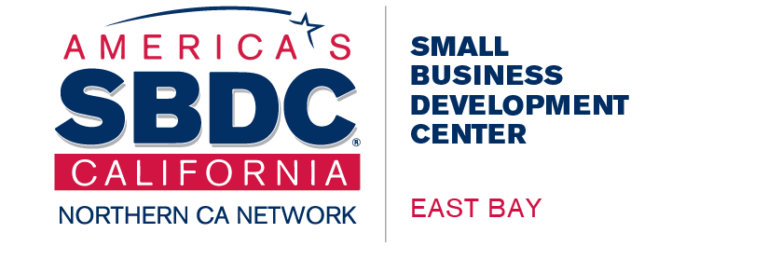
Resource Library
Introduction to customer analysis.
A customer analysis (or customer profile) is a critical section of a company’s business plan or marketing plan. It identifies target customers, ascertains the needs of these customers, and then specifies how the product satisfies these needs.
Customer analysis can be broken down into a behavioral profile (why your product matches a customer’s lifestyle) and a demographic profile (describing a customer’s demographic attributes).
A customer profile is a simple tool that can help business better understand current and potential customers, so they can increase sales and grow their business. Customer profiles are a collection of information about customers that help determine why people buy or don’t buy a product. Customer profiles can also help develop targeted marketing plans and help ensure that products meet the needs of their intended audience.
Behavioral Analysis (Customer Buying Criteria)
A behavioral analysis of customers (or psychographic profile) seeks to identify and weigh the relative importance of factors consumers use to choose one product over another. These factors, sometimes called buying criteria, are key to understanding the reasons that customers choose to buy your product (or service) versus the products offered by your competitors. The four major criteria that customers use to distinguish competing products are: price, quality, convenience andprestige.
In consumer transactions, price and quality tend to be the dominant factors. However with business-to-business (B2B) transactions (also called industrial marketing), service issues such as reliability, payment terms, and delivery schedule become much more important. The sales transaction in an industrial marketing scenario also differs from consumer marketing in that the purchase decision is typically made by a group of people instead of one person, and the selling process can be much more complex (including stages such as: request for bid, proposal preparation and contract negotiations).
By identifying customer needs through market research and analysis, companies can develop a clear and concise value proposition which reflects the tangible benefits that customers can expect from the company’s products. And once the primary buying criteria have been identified, marketing efforts can influence the customer’s perception of the product along the four main dimensions (price, quality, convenience and prestige), relative to the competition’s product.
Behavioral Analysis (Purchase Process and Patterns)
Occasionally, customer behavior analysis requires a more in-depth understanding of the actual decision-making process of the customer purchase. This may be especially true in an industrial marketing scenario. Examples of purchase process questions to be answered here include:
* What steps are involved in the decision-making process? * What sources of information are sought? * What is a timeline for a purchase (e.g., impulse vs. extended decision-making)? * Will the customer consult others in their organization/family before making a decision? * Who has the authority to make the final decision? * Will the customer seek multiple bids? * Will the product/service require significant modifications?
Behavior profiles can also focus on actions, such as: which types of items were purchased, how frequently items are purchased, the average transaction value, or which items were purchased in conjunction with other items. To understand the buying habits and patterns of your customers, answer the following questions:
* Reason/occasion for purchase? * Number of times they’ll purchase? * Timetable of purchase, every week, month, quarter, etc.? * Amount of product/service purchased? * How long to make a decision to purchase? * Where does the customer purchase and/or use the product/service?
Customer Demographics
The second major component in customer analysis is identifying target market segments that are predisposed to preferring your products over those of your competitors. A market segment is a sub-set of a market made up of people or organizations with one or more characteristics that cause them to demand similar product and/or services based on qualities of those products such as price or function. A marketing program aimed at individual segments needs to understand and capitalize on the group’s differences and use them strategically in all advertising campaigns.
Gender, age, ethnicity, geography and income are all market-segmenting criteria based on demographics.
Typical questions to ask when determining the demographics of the target market include: * What is the age range of the customer who wants my product or service? * Which gender would be most interested in this product or service? * What is the income level of my potential customers? * What level of education do they have? * What is their marital or family status: Are they married, single, divorced? Do they have kids, grandkids? * What are the hobbies of my target customers?
The target market segments are specified by demographic factors: age, income, education, ethnicity, geography, etc. Then by having a well defined set of demographic factors, marketing will be able to identify the best channels to reach these specific demographic segments.
Customer Analysis Example
Customer Analysis References
Market Analysis {U.S. Small Business Administration (SBA) Website’s content on Marketing Analysis} http://www.sba.gov/content/market-analysis
“Analyzing Customers in Your Business Plan” 2011 {Growthink, Inc.} http://www.growthink.com/businessplan/help-center/analyzing-customers-your-business-plan
Related Resources
Keyword Advertising
A guide to keyword advertising: online advertising that uses search engine keywords to trigger contextualized ads.
Google AdSense
A guide to Google AdSense: a free, simple way for website publishers to earn money by displaying targeted Google ads on their websites.
Online Advertising Networks
Ad networks are primarily involved in selling space for online ads. This online advertising inventory comes in many different forms, including space on websites, in RSS feeds in e-mails, and on other sources.
SBDC Intel™
Subscribe for updates, events and opportunities to network..

Subscribe for updates, events, and opportunities to network.
Get practical resources, important updates, and a calendar of online training, events, and more delivered to your inbox.
- First Name *
- Last Name *
Customer analysis: Definition, benefits & how to perform it the right way
Learn what customer analysis is, what the benefits are to investing in it, and how to perform it the right way.
What is customer analysis?
- Types of customer profiles
- Benefits of customer analysis
- How to do customer analysis
Customer analysis FAQs
Join our newsletter for the latest in saas.
By subscribing you agree to receive the Paddle newsletter. Unsubscribe at any time.
Understanding your customers and potential customers is a key aspect of being able to effectively market to them and build relationships with them. Careful customer analysis will provide you with the tools to convert more customers and keep them from churning for longer periods of time. In this post, we'll take a look at what customer analysis is, its benefits, and how to get started with it.

Customer analysis is a combination of qualitative and quantitative research collected on your customers with the purpose of better understanding them in order to draw meaningful conclusions that will aid you in your marketing and outreach efforts. It allows you to determine the needs of your customers, the types of messaging they respond well to, and why they are or aren't purchasing your product. Armed with this information, you can make the changes necessary to increase growth.
Two types of customer profiles you need to create
There are two different ways of looking at customers. Each of these will provide crucial insights into how to best target your messaging and guide future product decisions.
Customer behavioral profile
Creating a customer behavioral profile consists of two parts. The first part is understanding their buying criteria. Using market research and analytics, you can determine which features are most appreciated by customers, which needs are being underserved, and what price points they're willing to pay. Once you understand your customers' needs and willingness to pay , you can better tailor your product around those needs and price points. If you already have the features they value most, you can put additional effort into highlighting them in your marketing materials.
The second part of the behavioral profile is the purchasing patterns of your customers. What are they buying, and how frequently are they buying it? Which sales channels are they using to make a purchase, and where did they arrive from? What is the average time between first visit and first purchase? How long do they stay around before churning? All of these questions can inform your marketing decisions and allow for fine-grained tuning of your messaging and sales strategy.
Customer demographic profile
Demographic information such as age, location, income and education levels, gender, and more can give you a clearer picture of the type of messaging that will most resonate with customers and the marketing channels that can best reach them. The best way to determine which demographics to target for future marketing efforts is by looking at your existing customers. Building a marketing strategy around the types of people who are already purchasing is a great way to maximize the ROI of your marketing budget.
5 key benefits of performing customer analysis for any business
We've already touched lightly on some of the reasons that you should be doing customer analysis. Now let's take a closer look at some of the key benefits to show you just how important customer analysis can be to the sustained growth of your business.
1. Reduced churn & increased customer retention
One of the biggest reasons customers churn is because the product isn't fulfilling their needs. Customer analysis allows you to better understand what those needs are and tailor your product, your training materials, and your messaging to better address those needs before the customer churns.
2. Smarter product improvements
Knowing customer needs is a good way to decide what new features and improvements you should make to your product . By examining customer behavior to see which features are used and which are not, you'll have a better idea of what category of features customers find most useful, and which areas may need some improvement to increase usage.
3. Personalized and targeted marketing strategy
The most successful marketing departments create buyer personas for their customers. These are fictional characters that represent the various segments of customers that are most likely to purchase your product. The personas give you a more accurate target when determining what the tone of your messaging should be. You can also use analytics to target, in specific ways, customers who exhibit a certain behavior. This two-pronged personalization strategy results in a much more efficient marketing process.
4. Increased sales and revenue
When you're using buyer personas to communicate more effectively to potential customers, and using the other customer analysis you've performed, to more accurately address their pain points in both your messaging and your product development, you'll end up converting a higher number of potential customers into paying customers for increased revenue .
5. Lower CAC
Increased revenue alone isn't always a good thing. If you end up spending more to get that revenue, you're moving downward in profitability. Customer analysis allows you to make every aspect of the customer journey more efficient, meaning you'll be able to close more sales and keep customers around longer without spending more on marketing or other customer acquisition strategies .
How to do customer analysis in 8 steps
If your customer analysis is going to be effective, then it needs to be thorough. It's important that you gather the proper information and then apply it in the most meaningful way. The process can be outlined in eight broad steps:
1. Analyze your current customers
If you have a good analytics system in place, then you've already have a lot of data on how your customers behave. While market research looking outside of your customer base can help, looking at the people who have already purchased accomplishes the dual purpose of giving you specific access to how your product is used and providing you with information on the exact type of people likely to purchase from you.
2. Perform customer profitability analysis to identify the most valuable customers
Your entire customer base can give you plenty of good insights about which features are popular and similar generic metrics. But in order to know which types of customers to reach out to and which improvements are going to make the biggest impact on churn reduction, it pays to look at the type of people who have spent the most and/or stayed with you the longest. Keeping those customers happy and bringing in more like them will give you the most growth.
3. Perform customer needs analysis to discover the main purchase drivers
People make purchases based on needs. When you understand what your customers (and people similar to them) need from a product, you'll also understand what drives them to make a purchase. This data will play a big role in shaping the future development of your product and help you stay a step ahead of the competition.
4. Perform customer segmentation analysis to create customer segments
Customers can be segmented in a variety of ways. You can divide them by common demographic traits, common profitability metrics, common shopping or app-usage behaviors, and more. The data itself and customer segmentation tools will help guide you by grouping your customers into logical segmentation buckets. The data will help you determine your most profitable customers for the step above, but also show you which are in danger of churning, so you can take steps to avoid it.
5. Use customer data to create buyer personas
Armed with the customer segmentation data, the next step is to get to work crafting a fictional version of the major segments. These buyer personas will serve as the fictional embodiment of your customers, so the marketing, sales, and onboarding teams can communicate with them in a way they'll be most responsive to.
6. Acquire customer feedback
Analytics are a big driver of how you understand your customers, but they alone can't tell you everything. The best way to know what customers think is still the old-fashioned way of asking them. Getting routine customer feedback will keep you stay up-to-date on how customers feel about your product versus an ever-changing technological and competitive landscape.
7. Draw a customer journey map
Drawing a map of your current customer journey and comparing it with the feedback they've given and data you collected can help you identify points in the journey that are not currently being adequately addressed.
The technological landscape is constantly changing. What was state-of-the-art and adored by customers one day can be old news the next. It's important to keep that in mind and ensure that customer analysis is an ongoing effort on your part, and not something you do once and forget about.

Take the headache out of growing your software business
We handle your payments, tax, subscription management and more, so you can focus on growing your software and subscription business.
What should a customer analysis include?
When conducting a customer analysis, you should gather data about how customers are interacting with your product, what their pain points and needs are, what demographic and purchasing groups they belong to, and feedback directly from them about their feelings on your product.
How does customer data analysis help in the decision-making process?
Customer data analysis helps you to better understand what your customer's needs are and what features they interact with the most, to help guide you make accurate decisions for future product development. It also paints an accurate picture of who your customer is, allowing you to make more-informed decisions regarding ad-targeting and the tone of your ad copy and website text.
What are the types of customer analysis?
The two major types of customer analysis are behavioral analysis and demographic analysis. Behavioral analysis can be further divided into two subgroups: buying criteria and purchasing patterns.
Related reading

Customer Analysis
What is a customer analysis.
In many ways, customer analysis is the most important piece of your business plan. In order for your business to be successful, you must be able to demonstrate who will buy your products or services. Be sure to identify your customer segments and how your business will meet their specific needs.
Navigation:
- Step-By-Step Checklist
- Find Demographic Data
- Library Business Research Resources
- Public Opinion Polls
Step-By-Step Checklist
Begin with a concise overview of your industry. You can reiterate this from your Industry Analysis.
Define your prospects on a measurable level. Describe the demographics of your customers including their age, sex, race, occupation, household income, rent vs. own, postal code, population, spending habits and number in household, where they are located, etc. Be sure to cite all of your sources.
Describe changes over time and projected changes in the future.
Describe your customers' behavior. Consider how they make decisions and who in the household makes which decisions. Determine whether they respond to price, loyalty, quality, technology, reliability or trends. Divide your market into segments, assign value to each segment, and decide how to best approach each segment. Be sure to cite all of your sources.
Use your Competitive Analysis to provide an overview of your competition.
Use this information about your industry, customer prospects and competitors to identify gaps in the market.
Identify partners through the same research methods used for your industry analysis.
Find Demographic Data:
Census Profile - Statistics Canada Provides Canadian community profiles from the latest Census of Canada. These profiles are very useful for comparing statistics on different municipalities or regional districts. Includes details on family characteristics, primary language, mobility, educational attainment, marital status, labour force activity, earnings, and mode of transportation to work.
Find latest data from the 2016 Census
Thanks to Catie Sahadath at the University of Ottawa Libraries for building this widget.
Market Research Handbook - Statistics Canada A comprehensive source of socio-economic statistics. Data includes profiles of key industries, including the small business sector, as well as of consumers in all the provinces and in 45 major cities across Canada. Also includes information on international trade data, households, families, and selected economic indicators. The Market Research Handbook was published annually until 2008 but is now discontinued. A copy of the 2008 version in PDF format is available on their website.
Socio-Economic Profiles - BC Stats The socio-economic profiles consist of charts and tables for the various regional districts, health areas, college regions and school districts. Each region contains a map, demographic profile, economic hardship, labour market structure, education concerns, crime, health problems, children at risk, and youth at risk. The profiles are presented in a format that allows comparison to other regions in the province and to BC overall.
GeoSearch | Statistics Canada Use this tool for map views of census demographic and thematic data.
Search or browse all NAICS or SIC codes on the NAICS Association website . Some NAICS codes are different in Canada — you can search by keyword or browse Canadian NAICS codes at Statistics Canada or Canadian Industry Statistics. To search for a SIC code using a NAICS code and vice versa, use the NAICS & SIC Crosswalks.
For more information about planning your industry research, including identifying your industry codes, check out the video tutorial for Module 3: Planning Your Industry Research .
Library Business Research Resources:
Business resources at academic libraries .
Colleges and Universities with business programs will have useful business collections you may be able to get access to through their academic library. Often these academic libraries can provide the general public with access to their collections, which include electronic resources like databases and e-books. For example, they could have alumni or community cards, and can provide temporary "guest" passes in certain situations. Contact your local college or university library to see what they can provide. Please note: you probably will not get access to their electronic resources with remote access.
UBC Library Business Databases
How to access: If you are a UBC student, staff, faculty or in-person library visitor you may have access to business databases through the David Lam Management Research Library and Canaccord Learning Commons through the links below.
Full Listing By Title or Full Listing By Subject
There are two different ways to identify databases: Use "by title" if you already know the name; otherwise you can search the list "by subject" to find starting places for undertaking market research, finding articles or researching companies. To learn more about how you can access library resources if you are a community user or temporary visitor, check out the UBC Library Community Users & Visitors Guide . Community users and temporary visitors may have additional access restrictions to specific databases because of license agreements.
Discovering where you can access the information you need to complete your research can be tricky. Below, we have a few examples of potential sources that collect the type of information you will need.
- Canadian Advertising Rates and Data
- Vividata (formerly "Print Measurement Bureau")
- Roper Center for Public Opinion
Public Opinion Polls:
Gallup Search this website for news releases and additional resources from Gallup.
Ipsos Links to Canadian, U.S. and international polls. Includes polls on consumer goods.
Note: If possible, it is an excellent idea to conduct some primary market research on your customers. You can conduct focus groups, customer satisfaction measurements, field testing, etc.
Now you're ready to start writing your business plan !
Upmetrics AI Assistant: Simplifying Business Planning through AI-Powered Insights. Learn How
FREE DOWNLOAD
Customer Analysis Template
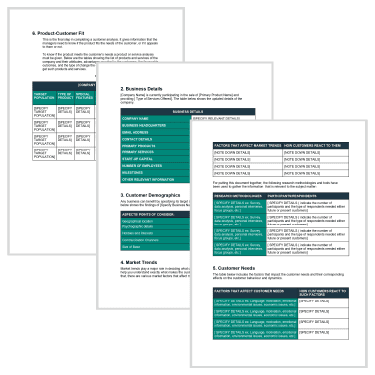
Free Template
Download and start using customer analysis templates for:.
- To understand and analyze your customers
- To understand if your customers need your product or service or not
- To deal with the foundational aspect of a business
- To make your business plan more effective
Download Your Template Now
Ready to kickstart your business planning.

– Don’t Miss It

Customer Analysis
Ai generator.

Every business should take care of its customers to promote trust, retention, and continuous relationship. However, this will not be effectively done if the business is not aware of who their customers are in the first place. Customer satisfaction is one of the most important things for any business to flourish. To keep this on track, you need to conduct a customer analysis now and then, so that you know what you can do to make your name and fame in the market better. This also helps you in retaining your customer base and expanding it if and when needed.
Simple Customer Analysis Template
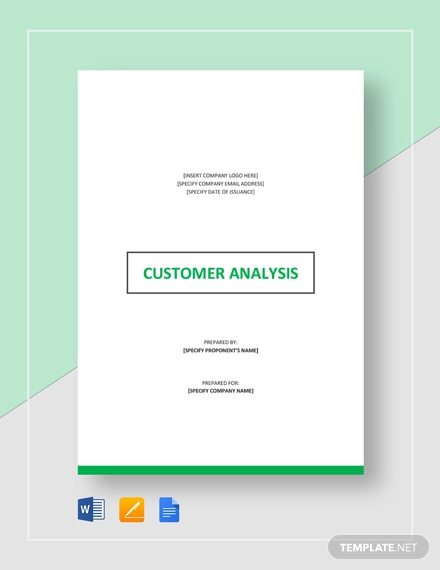
- Google Docs
Size: A4, US
Understand how your business generates revenue from your different customers and the different factors involved that affect your performance in meeting the needs of such customers through the use of this customer analysis t emplate. Identify which factors influence your customers in terms of how they respond and in their decision to buy or avail of any product or service you or other competitors are offering. Easily add or remove parts of the template you wish to be included. An added advantage of using this template is that it can be download with ease on any electronic device. Check it out now!
Restaurant Customer Analysis Template

Restaurants should be aware of their customers’ wants and need as these are the key factors of major business decisions. With the help of this above-mentioned template, you can make a professionally drafted and well-formatted analysis needed to help restaurant operators gather data. Usually from customer behavior via marketing segmentation and predictive analysis to direct marketing, site selection, and customer relationship management. Increase your potential to boost sales and profit with the use of this template now!
Customer Needs Analysis Template
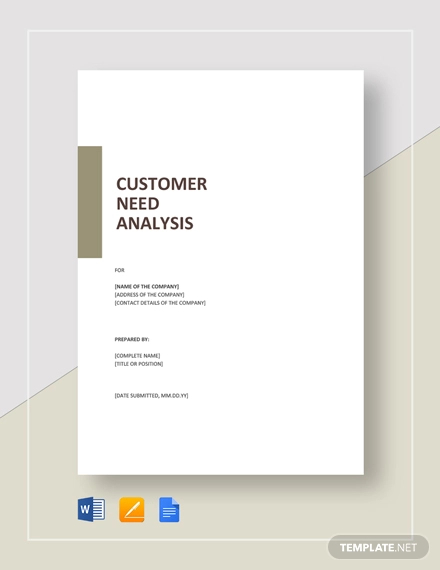
Are you looking for a business tool to identify the requirements customers have for a product or service? Well, you’re in luck for we have just the thing you need. This analysis sample template is professionally designed to help users understand the customers’ needs and their position in the overall market. It makes use of well-researched and industry-compliant content drafted by our experts. You can now save a lot of time and effort as you fo not have to make an analysis template right from scratch. Check it out now!
Customer Service SWOT Analysis Template
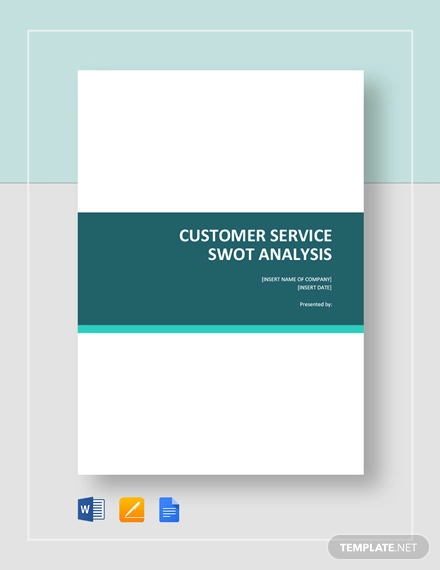
Customer Analysis Template

Simple Customer Profitability Analysis Example
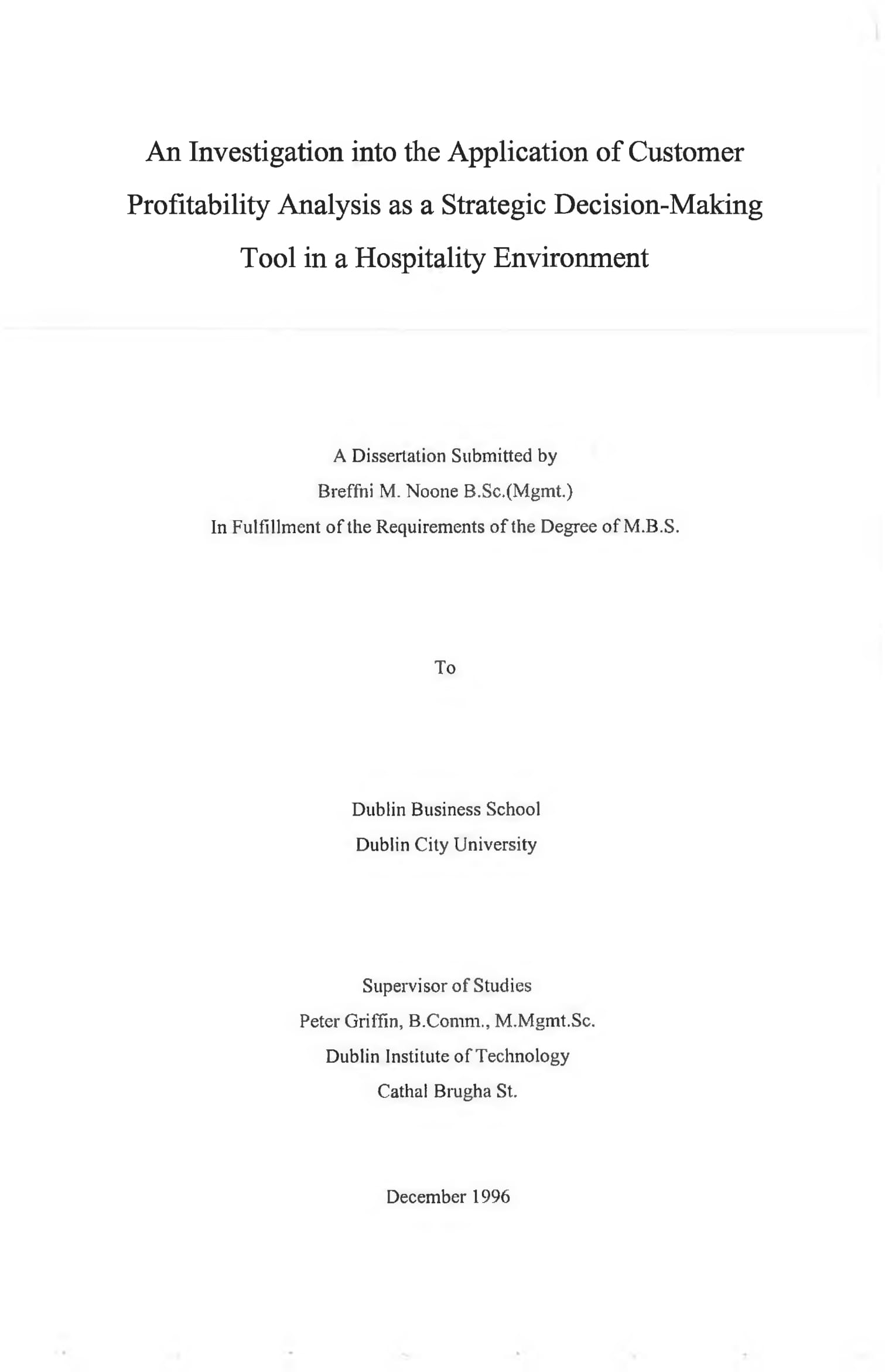
Customer Value Chain Analysis Example
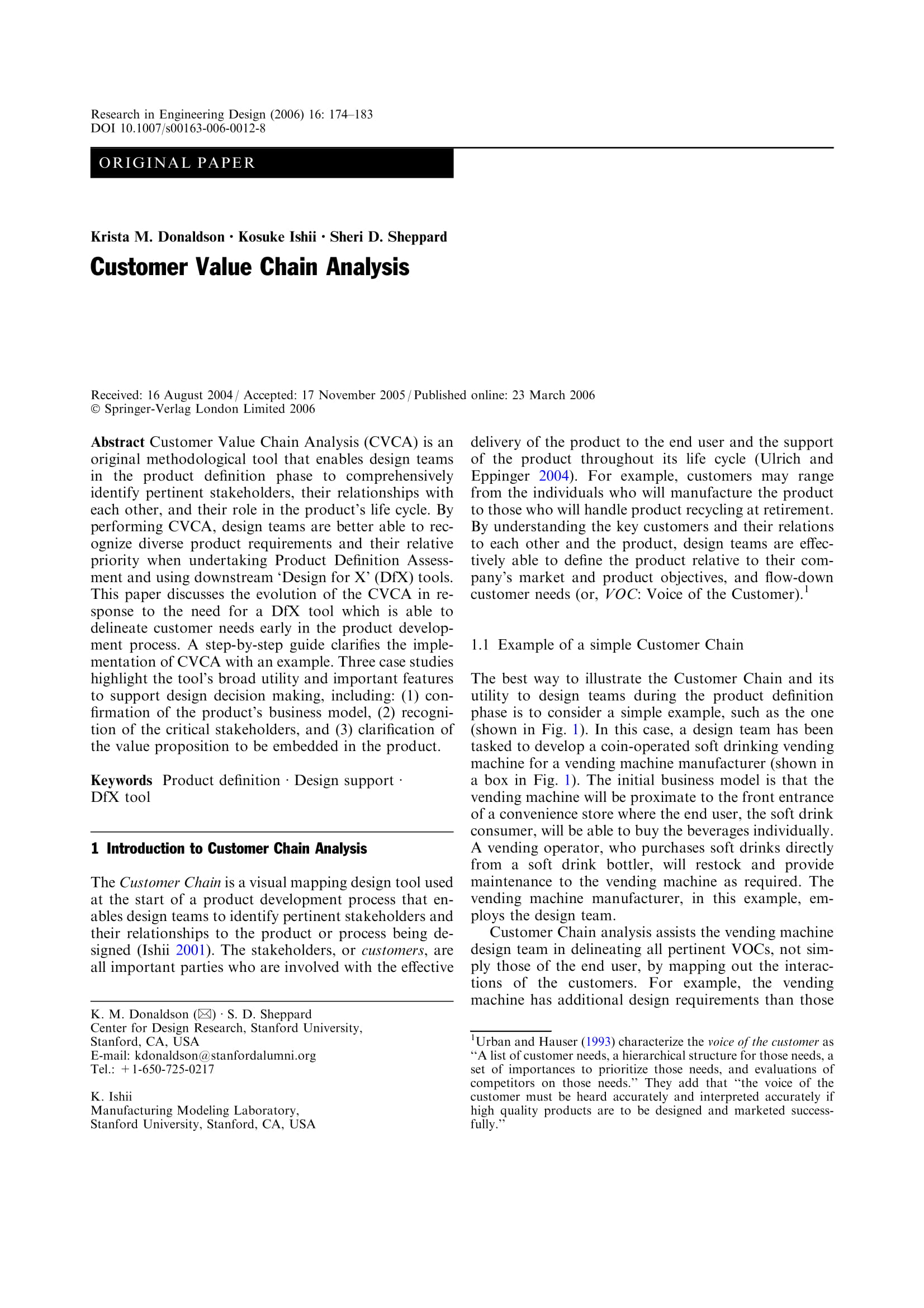
Size: 550 KB
Apart from industry analysis , knowing the needs and demands of your target and potential customers can also help you thrive and be successful in a stiff and competitive environment. If you want to achieve your business goals and objectives while sharing the marketplace with competitors, developing a customer analysis can help you a lot. If your business can have a full understanding of the elements that affect the purchasing decisions of your clients or customers, then you can easily make ways and adjustments on how you offer and market your products and/or services.
Why Does Your Business Need Customer Analysis
Using analysis examples provide businesses the chance to change or remove processes and activities that do not work, maintain efforts that yield the most favorable results, and develop activities that can get more clients for the business. Aside from these, listed below are more reasons why your business needs to have its customer analysis:
- Customer analysis can help you focus on the acquisition of new customers while maintaining your current customer base. Planning your programs for retention can be more effective if you are knowledgeable on how you can show to your previous customers that they matter. The investment analysis examples that are available online can be of great help to you. Check them out now.
- Customer analysis can give you an idea of how you can cross-promote your offers and discounts to the right audience. This way, you can achieve higher sales without hard selling your products and/or services to customers.
- Customer analysis can help your business now your customers and their levels of engagement in the business you are running. This can help you develop strategies that can further improve your market positioning. Essay examples can also be of great help to you in making the right needed essays.
- Customer analysis can make your business better in terms of customer satisfaction and service. With the help of the customer analysis at hand, you can easily identify the factors that can help you satisfy customers and keep them in your business.
- Customer analysis helps your market disassembly decisions better and this leads to a better success rate. You may also check out needs analysis examples . This document can easily allow you to target potential customers from a specific group or range since you are already aware of their activities and how your offers can impact their daily undertaking.
- Customer analysis can also give your business a higher chance of retaining and also, pulling in new customers and making them patrons. Loyalty can be developed between the business and the market if you can consistently give the demands and needs of your clients.
- Customer analysis can contribute to the success of your marketing campaigns from its stages of planning up to final execution. With a comprehensive customer analysis, you can target specific customers in given demography in the most cost-efficient and effective way possible. You might be interested in organizational analysis examples .
Customer Analysis and Targeting Example
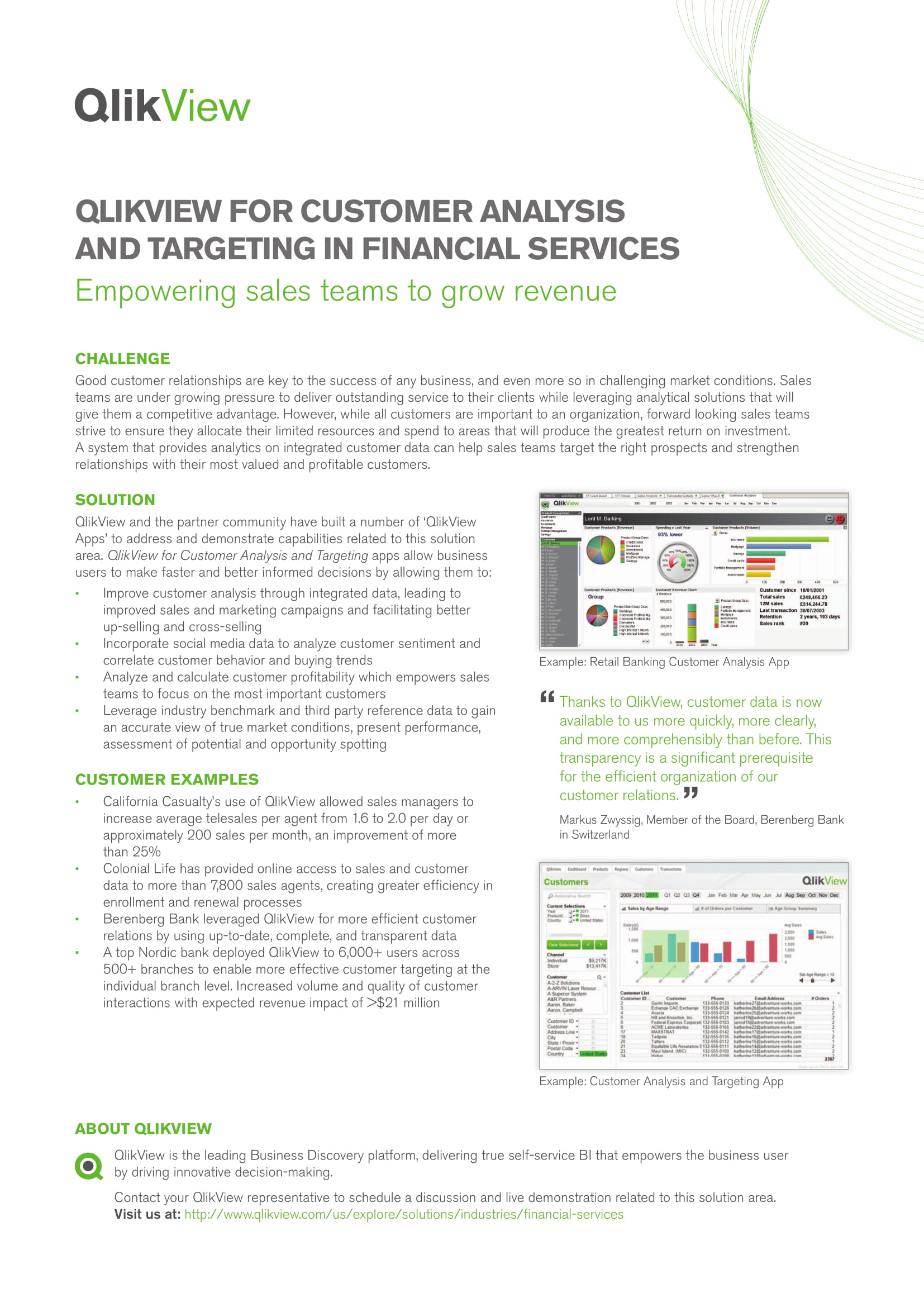
Size: 331 KB
Defining Customer and Business Requirements Example

Size: 673 KB
Basic Consumer Behavior Analysis Example

Size: 276 KB
Customer Profitability Analysis Example
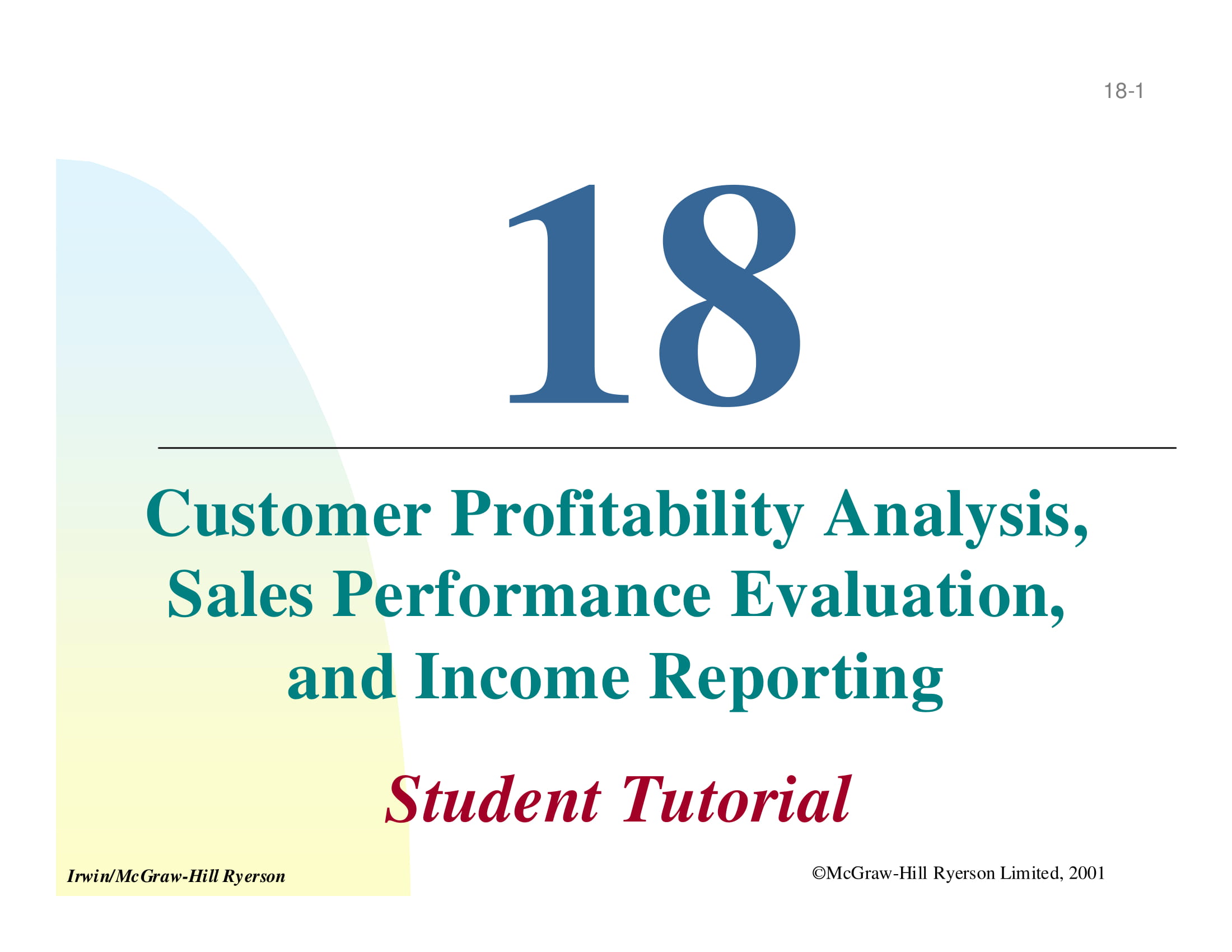
Size: 279 KB
Market Analysis and Audience Research Example
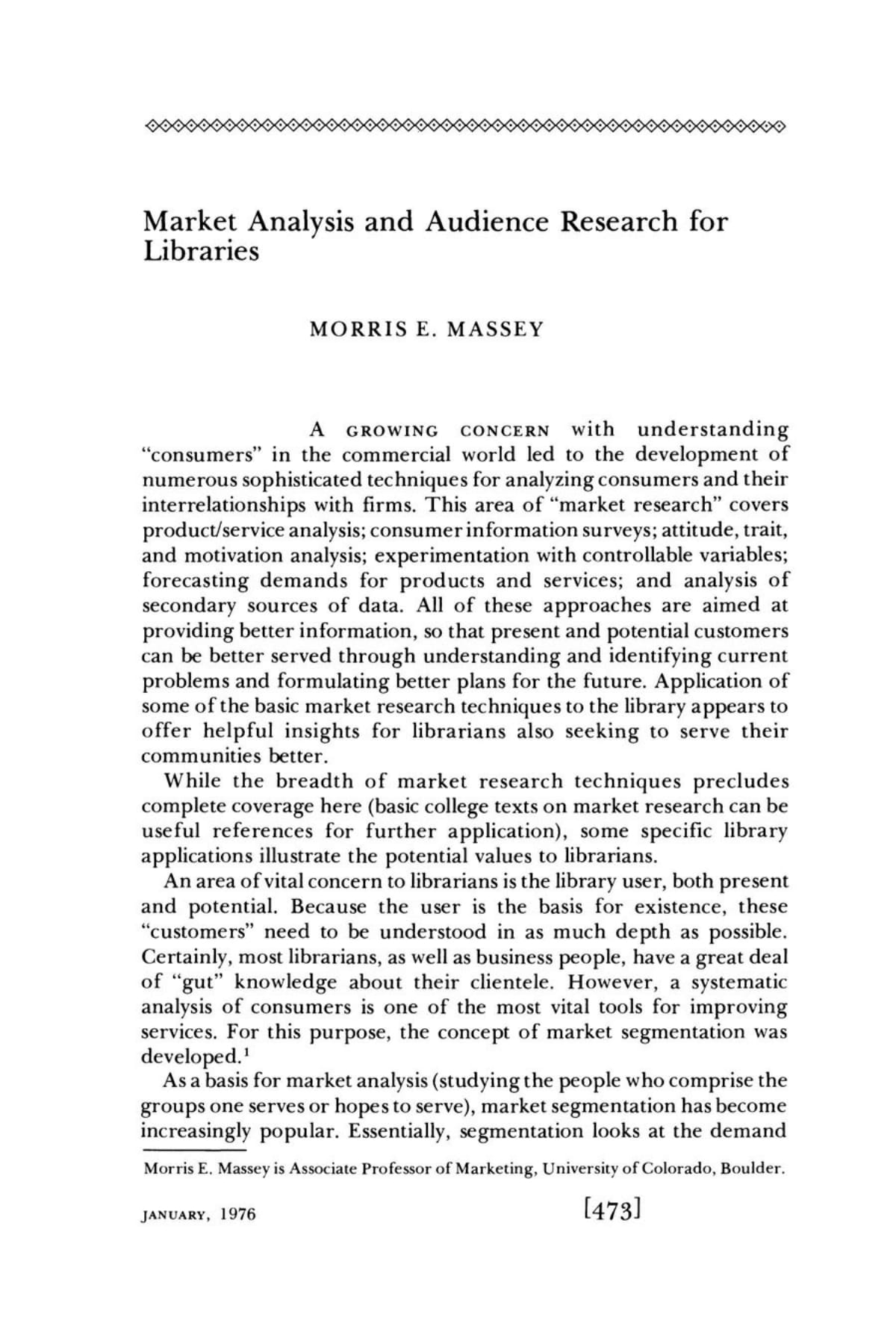
Customer Behavior Analysis Example

Needs-Based Analysis Customer Reviews Example
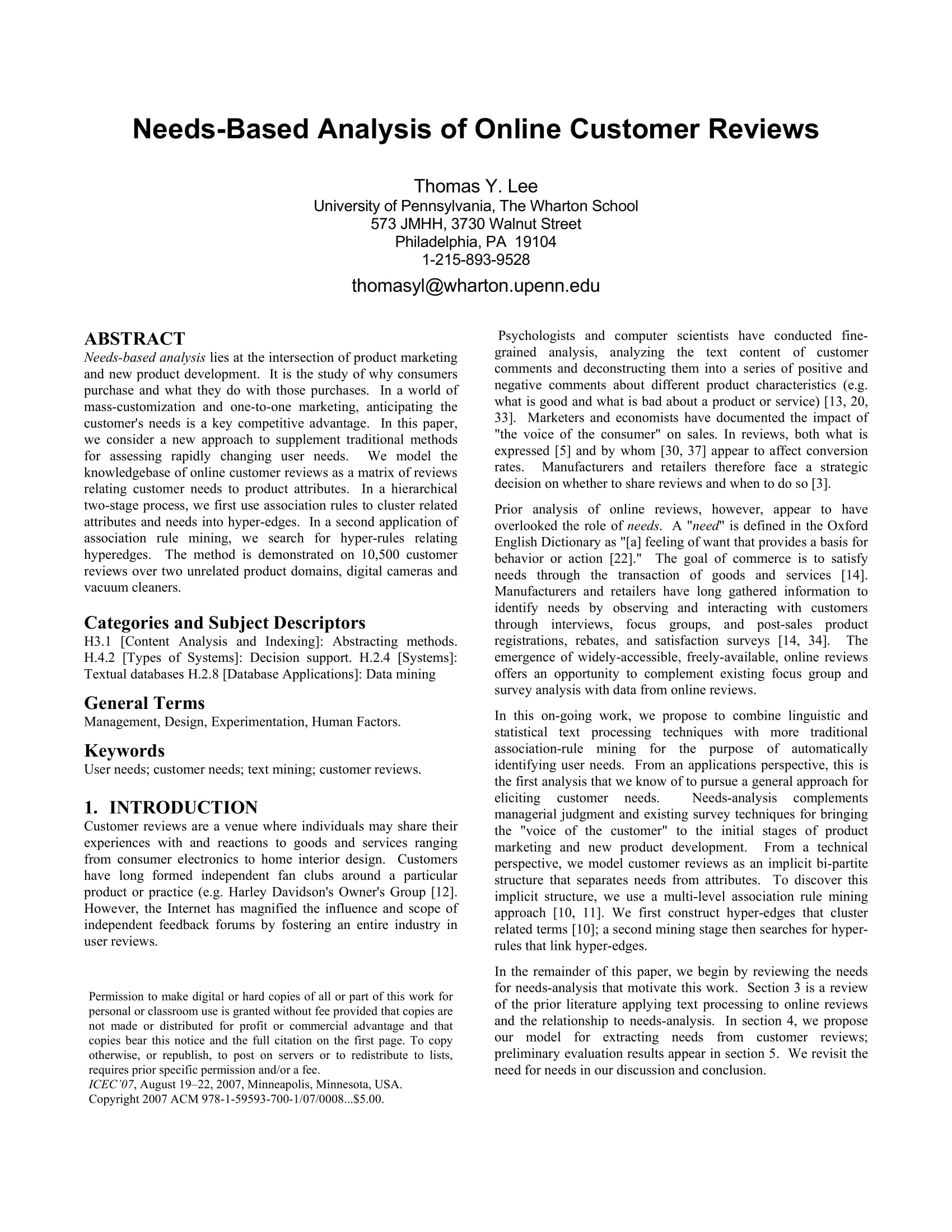
Size: 243 KB
Customer Analysis and Market Strategy Example
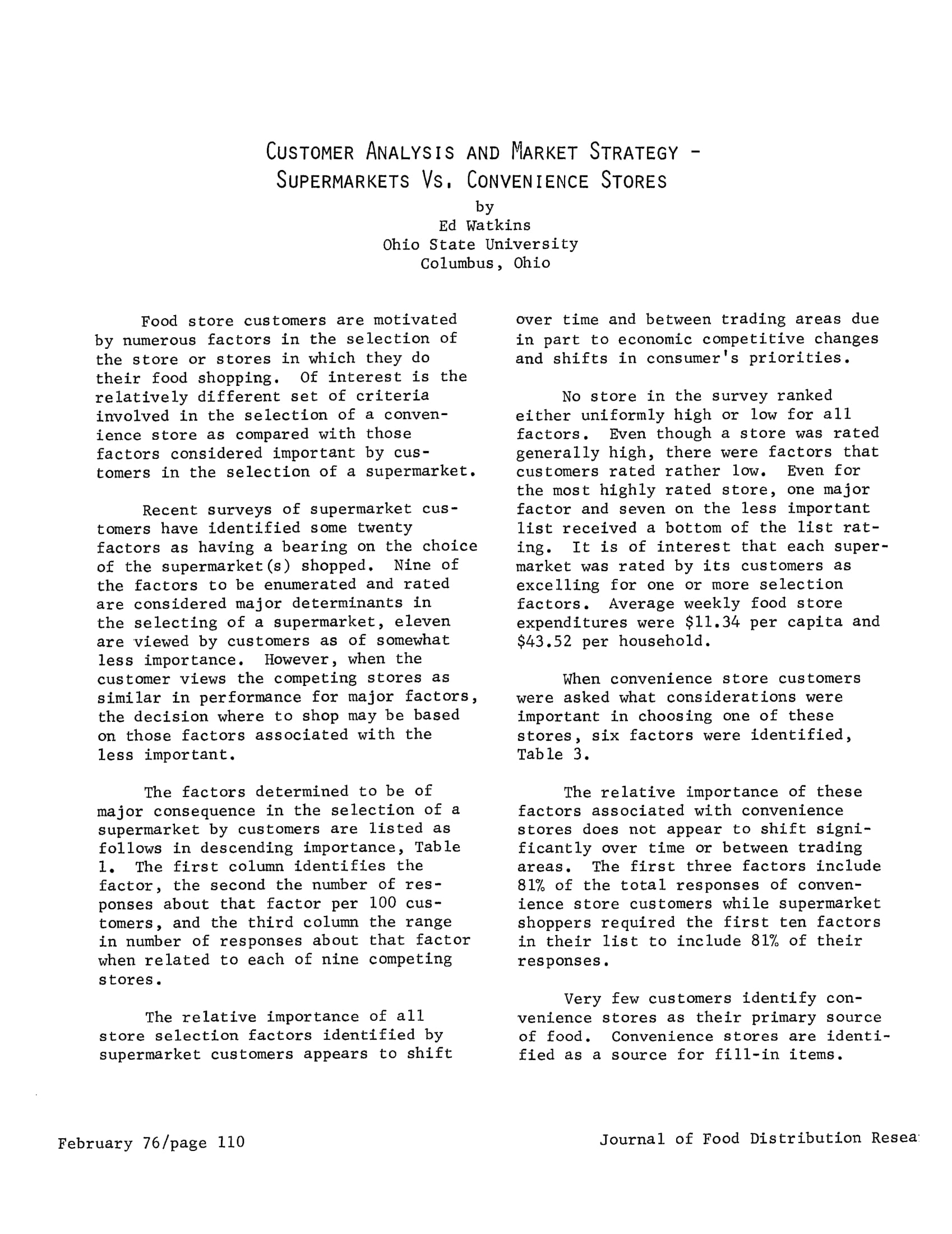
Size: 228 KB
Customer Needs Analysis Example
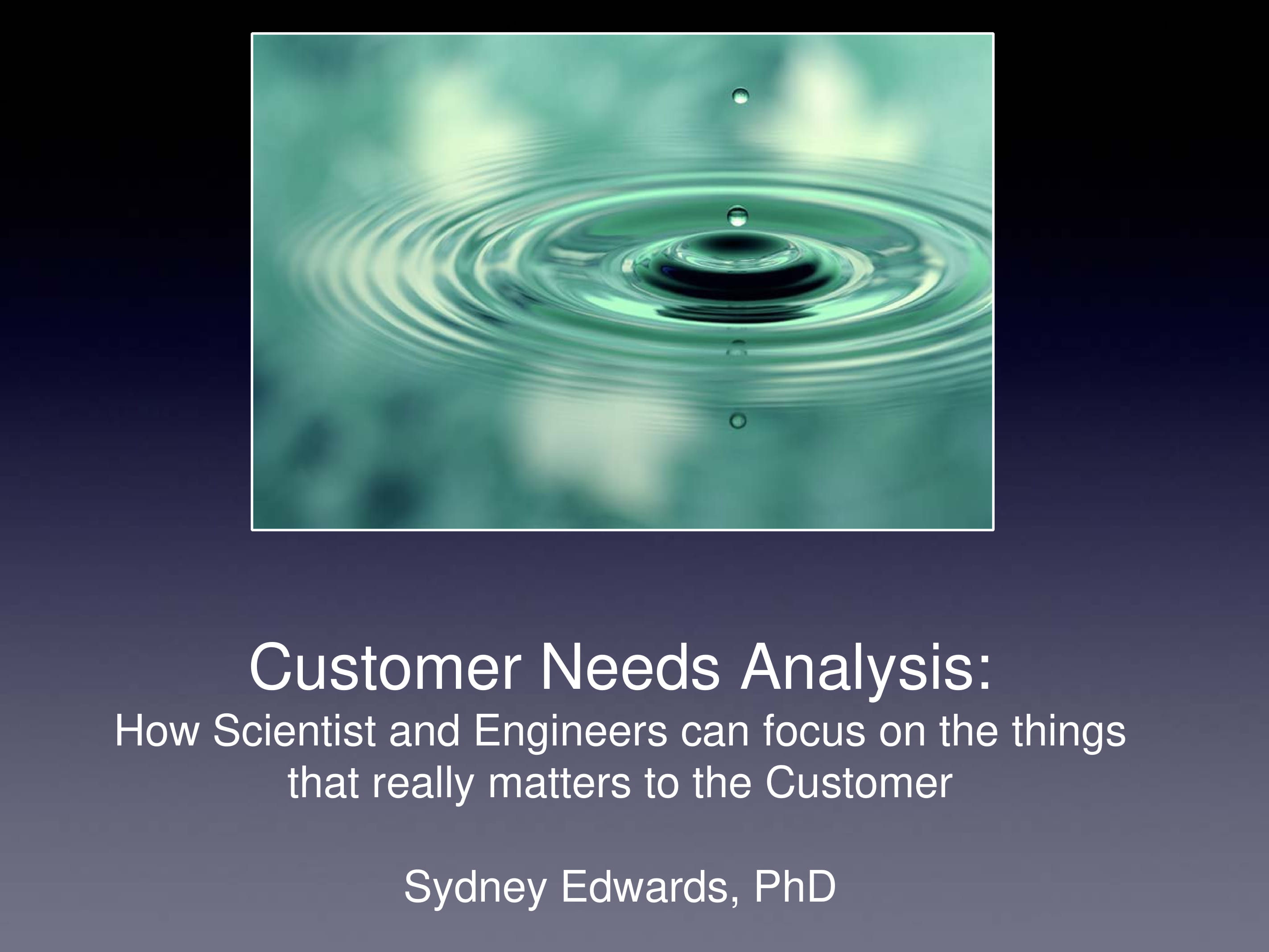
Size: 683 KB
Benefits of Having Customer Analysis:
Aside from survey questions to ask your customers , you also have to develop an effective customer analysis that can further showcase the movement and activities of your target market. If you can make a thorough and professionally formulated customer analysis, then there are a lot of potential advantages that your business can experience. Here is how your business can benefit from having customer analysis:
- Creating a cusotmer analysis can presnt your business accurately and as per the market place. If you know how the perception and impression of your customers can affect your business, then you can make corporate messages and branding statements that can segment your customers better. Requirements analysis examples and samples can be of great help to you.
- Making a customer analysis can reduce your business’ cost of campaigning and marketing as this gives all the customers a gist fo what you do without the need for marketing. If you already know who to specifically target, then your budget for advertising and promotion will not be put to waste. Business analysis examples can be of great help to you. This document can also help you to narrow down your marketing efforts based on what are the most necessary and beneficial for your business.
- Developing a customer analysis can help you keep in touch with the right customers. This can lead to a faster return of investments as you can increase customer loyalty which is very important if you want people to continue purchasing your products and other offers.
- Having a customer analysis can lessen the possibilities of attrition. If you will be aware of the level of relationship that you have with customers in terms of their purchasing activities, then you can already predict the customers who can potentially discontinue their support to the business. With this, you can develop programs that can help these customers stay for the business to still benefit from their purchasing power.
Market Analysis for Customer Segmentation Example

Size: 837 KB
Repeat Customer Presentation Analysis Example
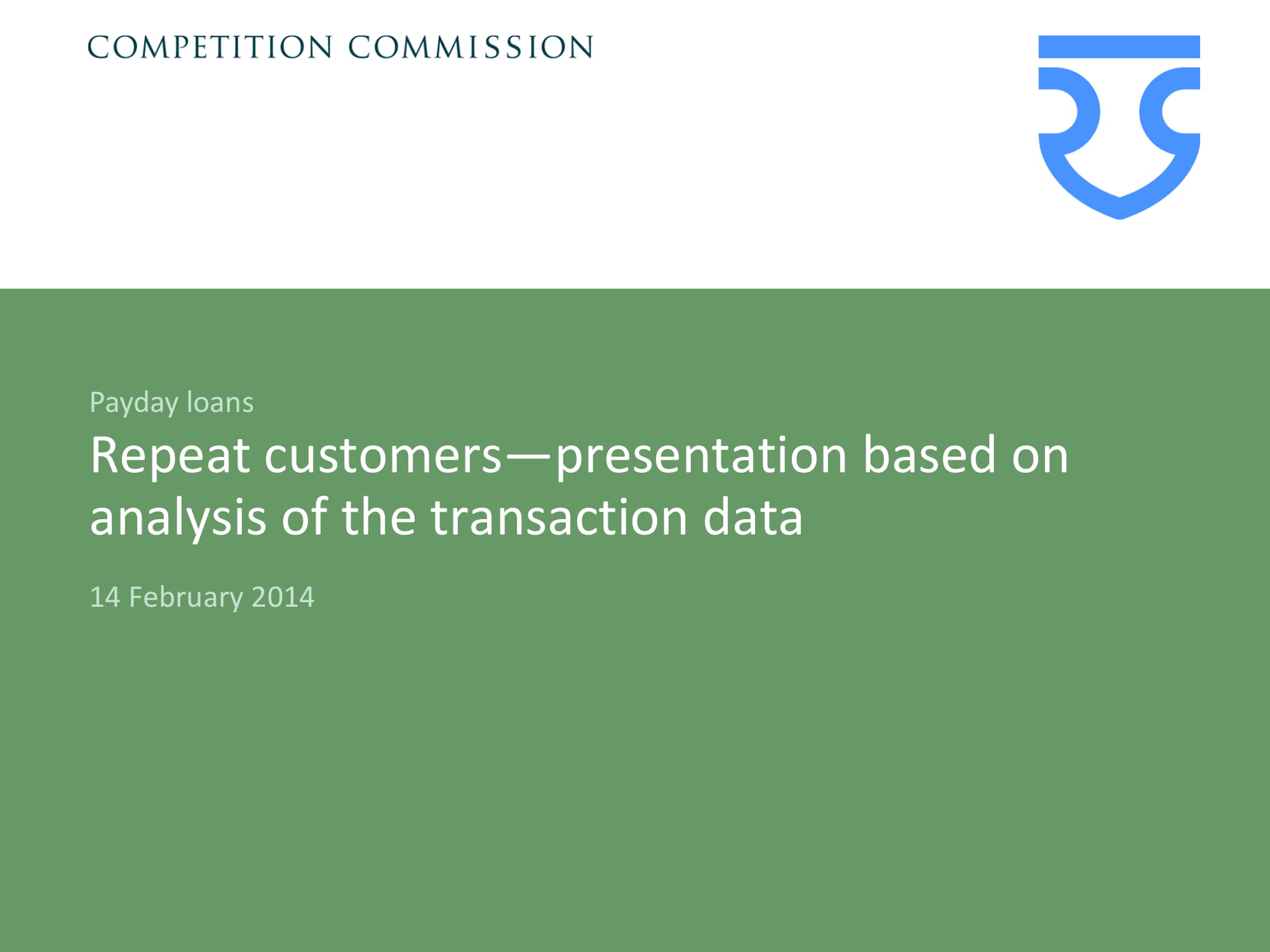
Size: 408 KB
Tips in Developing Customer Analysis:
The studies and researches that you will implement for your business are aligned with one another. A customeer anaysis can stregthen the claoms and the results of the market on the whole. You can check market analysis – demand and supply for more. This can also go the other way around if you want to ensure that the demand of the customers is truly aligned with how you prepare the supply of the business.
Before making a customer analysis, you must know what are the basic factors and elements that need to be added in an analysis in the first place. This means that you need to consider to gather the precise and necessary information so you can make the most useful and effective customer analysis results. Aside from that, a few of the tips that can help you develop an impressive customer analysis include the following:
- You need to carefully analyze the habits and activities if your clients. The content of the customer analysis of your business needs to be based on first-hand information. Doing this can make the document more effective. Take a look at operational analysis examples and samples for more.
- Other than the basic and known factors that can affect the purchasing decisions of new customers, you also need to seek for the reaction and comments of these customers after buying an item from your business or acquiring your services. Be reminded that new customers can share information about your business and the details that they will disclose can affect the perception of other people who have not tried your offers yet. You may also want to see the process analysis examples and samples that are available online for more.
- You can be well organized within the process of development if you use the customer analysis perfectly. You have to make sure that the steps of the customer analysis procedure, the materials that you will need for data gathering, and the metrics and measures that you will follow are prepared and well-arranged. This can result in a great customer analysis document that is complete and easily understandable to others. You can check the sales analysis for more.
- Allow the customer analysis to be a part of the business plan you make. It is essential for the information that you will gather in this activity to serve as the foundation of the new strategies of your company.
- If you will refer to existing examples that you can download, it will be easier for you to create a custom analysis of your own without sacrificing the document’s quality. Check root cause analysis for more.
Approaches to Customer Analysis Example
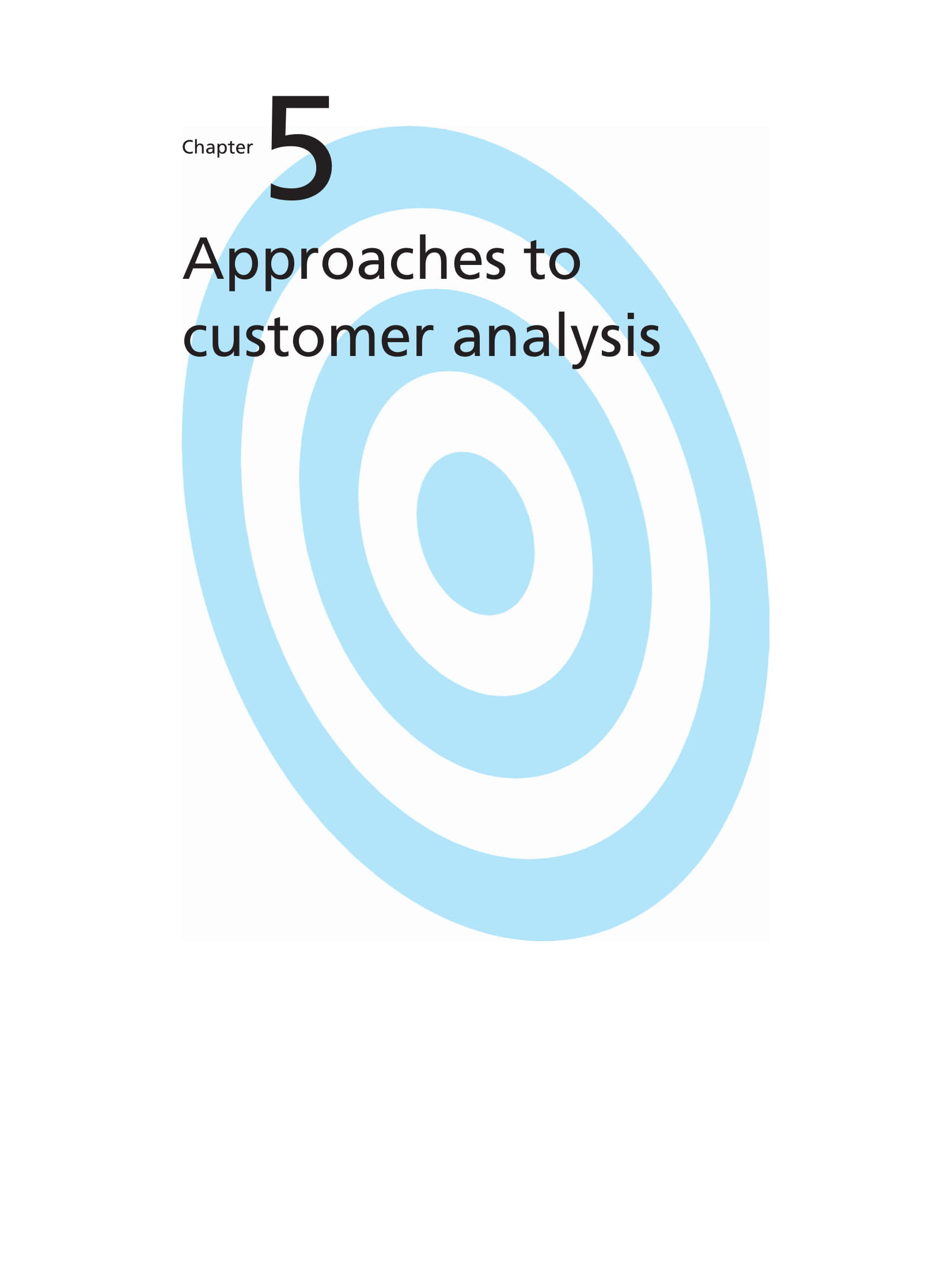
Size: 662 KB
Customer Analysis Presentation Example
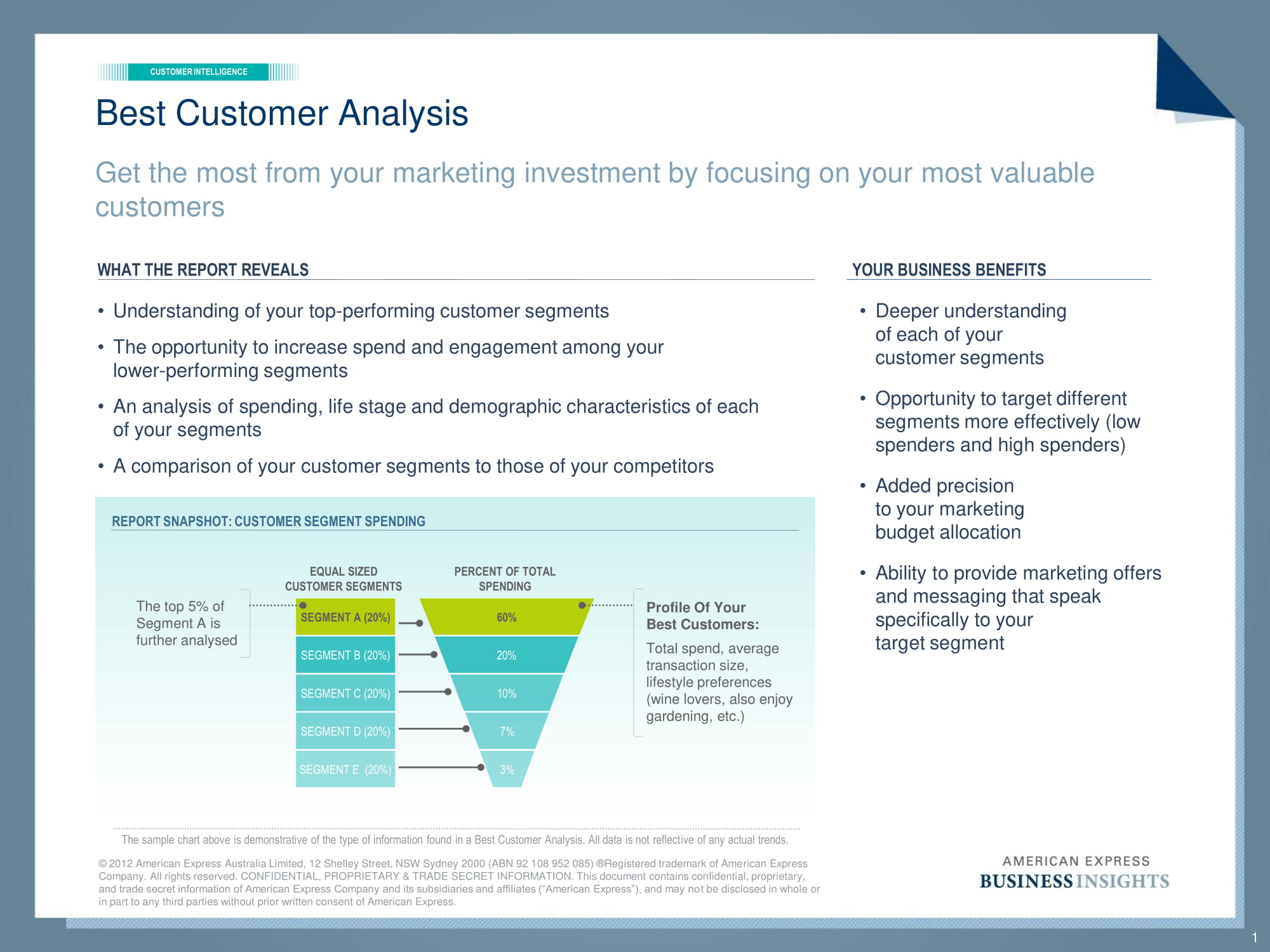
Size: 111 KB
Customer Analysis – Discussion and Example

Size: 385 KB
How Does Customer Analysis Affect a Business?
If you want to know to use a SWOT analysis , then the first thing you need to do is know the internal and external factors that can affect your business. In one way or another, having customer analysis can truly impact your business and the way it operates. A few changes that can occur if you use a customer analysis are mentioned below. They are:
- You can attract potential customers into trusting your brand and what you can provide them with.
- You can take a foot forward from your competition in the market.
- You can benefit financially as an increase in actual sales can be achieved.
- You can present the quality and value of your products and/or services accordingly.
If you are unsure of how to create a customer analysis, then the template in this article can be of great help to you. These examples and other information can be of great use so that you can make the needed document. Make sure to use the maximum potential of these references as having a well-thought and carefully planned customer analysis can be one of the strengths of your business. Financial analysis examples and samples can also be of great help to you in making the needed financial decisions as and when needed.
Text prompt
- Instructive
- Professional
10 Examples of Public speaking
20 Examples of Gas lighting
Target Market Examples
Elon Glucklich
7 min. read
Updated April 24, 2024
Imagine your dream is to own a diner.
You have restaurant experience and a great location in mind – you just need the bank to approve your loan to get started.
But the bank has questions. A big one it wants answered is: who is your target market?
It might be tempting just to say, “hungry diners.” But you’ll need to dig deeper to truly define your target market .
In this article, we’ll use this diner scenario to walk through the market research process and illustrate what the final result could look like.
- Questions about your target market
Before you even set foot in the bank, you should already have asked – and taken steps to answer – several key questions about your target market.
Let’s call our example business the Bplans Diner. Where is that perfect location you’ve found for the diner? Is it in a densely populated urban area, suburban neighborhood, or rural?
What are your hours of operation? Some diners cater to a breakfast crowd, while others might offer 24-hour dining to be a favorite among night owls. When you expect your peak hours could help determine whether you should expect to sell more omelets or hamburgers.
What’s the area’s median income, and what types of businesses or institutions are nearby? This information will help you determine pricing and marketing strategies for your diner. For instance, if your diner is located in a business district, you may want to offer lunch specials. But if it’s near a college or university, you might want to offer student discounts.
This is what a thorough target market analysis looks like, providing key insights and data to pinpoint the specific groups of customers most likely to patronize your diner. Gathering all of this information may sound intimidating, but it’s really just a matter of doing research. If you need help and guidance, check out our complete guide to conducting market research for your business .
Let’s look at an example of a target market analysis for this diner. Then, we’ll break it down and discuss each element in detail.
- Example of a target market analysis

As you can see, the target market analysis follows the basic market segmentation process of splitting out potential customers into their demographic, geographic, psychographic and behavioral traits.
Next, let’s take a look at each in more detail. Afterward, we’ll look at how you can harness your target market analysis into actual business strategies.
- Demographic
You may have noticed that the demographic analysis in our example is very broad – 18 to 65 years old, including students, workers, and some seniors.
Finding your target market isn’t always about identifying a narrow demographic to cater to. In the case of a restaurant, it makes sense to focus on the geographic location and who currently frequents the area (more on that in the next section).
A different approach may be needed for a technology product that’s sold online. In that case, narrowing the demographic focus to specific age ranges or needs would be much more important than where the business is located.
In the case of the diner, we reached our decision by conducting a demographic analysis, examining the age ranges, occupations, and other concrete data points about potential customers near the proposed location (Reminder: we didn’t do this for the Bplans Diner, we’re just providing an example).
There are several ways to go about collecting this information for your business. The most straightforward is to get out in the neighborhood, take a look around and talk to people. Are you mostly seeing students, or families? Are there a lot of office workers in the area?
You can also look up data from the U.S. Census Bureau , which includes population, age, income and other useful information, often down to the neighborhood level.
After conducting this research, one valuable step is to create a detailed customer persona that represents the typical customer you expect for your business (we provide an example of a customer persona for the diner further down in this article).
While the demographic analysis considers the type of people who might frequent your business, the geographic analysis considers the characteristics of the neighborhood itself.
Our target market analysis for Bplans Diner noted that we plan to operate in an urban area near a university with heavy foot traffic and expect a fair amount of late-night diners.
A key reason for examining the geographic makeup of your businesses is to size up your competition. If there’s already a popular diner in the area you plan to target, getting customers could be a major challenge. But if there’s a lack of dining options or no one is serving diner-style food, you’re more likely to be successful. Determining the size of your market will help you create reasonable revenue projections.
We also mentioned the plan for Bplans Diner to cater to a late-night crowd. Examining the geographic makeup of the neighborhood will help you determine if there are the kinds of businesses – bars, music venues, or businesses such as hospitals where people are working all hours – to justify targeting this group.
- Psychographic
You know the demographics and geographic characteristics of your market. Now it’s time to consider the attitudes and values of your potential customers.
The psychographic analysis helps to understand the lifestyle of potential customers and how that might affect their preferences as consumers. If many of your potential customers are health-conscious, for instance, you’ll want to ensure your diner provides options like salads or gluten-free menu items. But if most customers are families looking for a place to bring their children, it may be important to keep classic items like hamburgers and french fries on the menu.
The best way to understand your potential customers’ attitudes is to get out and talk to them. Customer interviews are among the most powerful methods of validating a business idea , since you’ll get honest, real-time feedback from the kinds of people your business would depend on.
Finally, the behavioral analysis expands on customer psychographics by examining what customers do, given their values. This is another place where it’s worth considering the broad demographics of the diner’s target market – 18 to 65 years old, split among students, workers, and seniors.
They may all want the diner’s food, but their behaviors will vary widely. College students might be looking for a late-night study spot, or a place to meet up with friends for dinner before a concert or sporting event. But workers and seniors might be more interested in breakfast or lunch specials.
Each of these behaviors gives a business owner valuable information to target individual segments of their target audience. For instance, you might want to play popular music in the evenings to get young diners ready for a night out on the town. But you’ll want a quieter ambiance at the time of day when seniors are most likely to come in. The environment can be adjusted based on when certain customers frequent the business.
Addressing behavioral aspects like buying motivations and concerns of your potential customers will also help you effectively market your diner. For example, you could create marketing campaigns based on student discounts, late-night specials, or a family-friendly atmosphere, depending on your customers’ behaviors.
- Connecting a target market analysis to business strategy
So far, we’ve touched on each of the components of a target market analysis for a diner: customer demographics, geographics, psychographics, and behaviors. (It’s also important to conduct an industry analysis to understand competitive and macroeconomic forces affecting your planning.)
With the target market analysis complete, you’re better equipped to demonstrate a thorough understanding of your customers to a lender.
Here are a few insights a business owner could use for the Bplans Diner, developed through the above analysis.
- Bplans Diner Competitive Analysis
Market Trends: Growing demand for late-night food options, increasing preference for healthy dining options.
Competitor Strengths and Weaknesses:
Competitor A: Strong brand but limited menu options.
Competitor B: Wide variety of options but lacking in ambiance.
- Bplans Diner Marketing Strategy
Product Differentiation: Offering a diverse menu that caters to various preferences, including healthy options.
Positioning: Establishing Bplans Diner as a reliable, quality, 24-hour dining option in the region.
Promotion: Utilizing social media to announce special night-time deals and promotions.
- Get started with your business plan template
A target market analysis is a key part of any business plan. But it’s just one piece. At Bplans, we take some of the pain out of business planning. We’ve developed a free business planning template to help reduce entrepreneurs’ time to create a full, lender-ready business plan. Bplans has also collected over 550 free sample business plans across numerous industries. Find a plan in your industry to get inspiration for your plan.
Brought to you by
Create a professional business plan
Using ai and step-by-step instructions.
Secure funding
Validate ideas
Build a strategy
Elon is a marketing specialist at Palo Alto Software, working with consultants, accountants, business instructors and others who use LivePlan at scale. He has a bachelor's degree in journalism and an MBA from the University of Oregon.

Table of Contents
Related Articles

8 Min. Read
How to Conduct an Industry Analysis

10 Min. Read
How to Create a Detailed User or Buyer Persona

9 Min. Read
How to Write a Customer Analysis

4 Min. Read
How to Define Your Target Market
The Bplans Newsletter
The Bplans Weekly
Subscribe now for weekly advice and free downloadable resources to help start and grow your business.
We care about your privacy. See our privacy policy .

The quickest way to turn a business idea into a business plan
Fill-in-the-blanks and automatic financials make it easy.
No thanks, I prefer writing 40-page documents.

Discover the world’s #1 plan building software

Hotel Business Plan Template
Hotel customer analysis.
Anyone who has ever traveled is a potential hotel customer, but not all of them are your potential customers. Who will choose your hotel? Are they traveling for business or pleasure? Are they in town for a wedding or other special event? Do they travel with small children? How often will they visit your city? Are they price conscious? Do they want the latest amenities? Luxury bedding and robes? Are they rugged outdoors types? Figure out your customers’ demographics and how they decide where to stay. Then identify their unique needs and draw up a plan for meeting those needs.
HOTEL BUSINESS PLAN OUTLINE
- Hotel Business Plan Home
- 1. Executive Summary
- 2. Company Overview
- 3. Industry Analysis
- 4. Customer Analysis
- 5. Competitive Analysis
- 6. Marketing Plan
- 7. Operations Plan
- 8. Management Team
- 9. Financial Plan
- 10. Appendix
- Hotel Business Plan Summary
Start Your Hotel Plan Here
Other Helpful Business Plan Articles & Templates

Filter by Keywords
10 Free Business Plan Templates in Word, Excel, & ClickUp
Praburam Srinivasan
Growth Marketing Manager
February 13, 2024
Turning your vision into a clear and coherent business plan can be confusing and tough.
Hours of brainstorming and facing an intimidating blank page can raise more questions than answers. Are you covering everything? What should go where? How do you keep each section thorough but brief?
If these questions have kept you up at night and slowed your progress, know you’re not alone. That’s why we’ve put together the top 10 business plan templates in Word, Excel, and ClickUp—to provide answers, clarity, and a structured framework to work with. This way, you’re sure to capture all the relevant information without wasting time.
And the best part? Business planning becomes a little less “ugh!” and a lot more “aha!” 🤩
What is a Business Plan Template?
What makes a good business plan template, 1. clickup business plan template, 2. clickup sales plan template, 3. clickup business development action plan template, 4. clickup business roadmap template, 5. clickup business continuity plan template, 6. clickup lean business plan template, 7. clickup small business action plan template, 8. clickup strategic business roadmap template , 9. microsoft word business plan template by microsoft, 10. excel business plan template by vertex42.
A business plan template is a structured framework for entrepreneurs and business executives who want to create business plans. It comes with pre-arranged sections and headings that cover key elements like the executive summary , business overview, target customers, unique value proposition, marketing plans, and financial statements.
A good business plan template helps with thorough planning, clear documentation, and practical implementation. Here’s what to look for:
- Comprehensive structure: A good template comes with all the relevant sections to outline a business strategy, such as executive summary, market research and analysis, and financial projections
- Clarity and guidance: A good template is easy to follow. It has brief instructions or prompts for each section, guiding you to think deeply about your business and ensuring you don’t skip important details
- Clean design: Aesthetics matter. Choose a template that’s not just functional but also professionally designed. This ensures your plan is presentable to stakeholders, partners, and potential investors
- Flexibility : Your template should easily accommodate changes without hassle, like adding or removing sections, changing content and style, and rearranging parts 🛠️
While a template provides the structure, it’s the information you feed it that brings it to life. These pointers will help you pick a template that aligns with your business needs and clearly showcases your vision.
10 Business Plan Templates to Use in 2024
Preparing for business success in 2024 (and beyond) requires a comprehensive and organized business plan. We’ve handpicked the best templates to help you guide your team, attract investors, and secure funding. Let’s check them out.

If you’re looking to replace a traditional business plan document, then ClickUp’s Business Plan Template is for you!
This one-page business plan template, designed in ClickUp Docs , is neatly broken down into the following sections:
- Company description : Overview, mission, vision, and team
- Market analysis : Problem, solution, target market, competition, and competitive advantage
- Sales and marketing strategy : Products/services and marketing channels
- Operational plan : Location and facilities, equipment and tools, manpower, and financial forecasts
- Milestones and metrics: Targets and KPIs
Customize the template with your company logo and contact details, and easily navigate to different sections using the collapsible table of contents. The mini prompts under each section guide you on what to include—with suggestions on how to present the data (e.g., bullet lists, pictures, charts, and tables).
You can share the document with anyone via URL and collaborate in real time. And when the business plan is ready, you have the option to print it or export it to PDF, HTML, or Markdown.
But that’s not all. This template is equipped with basic and enterprise project management features to streamline the business plan creation process . The Topics List view has a list of all the different sections and subsections of the template and allows you to assign it to a team member, set a due date, and attach relevant documents and references.
Switch from List to Board view to track and update task statuses according to the following: To Do, In Progress, Needs Revision, and Complete.
This template is a comprehensive toolkit for documenting the different sections of your business plan and streamlining the creation process to ensure it’s completed on time. 🗓️

If you’re looking for a tool to kickstart or update your sales plan, ClickUp’s Sales Plan Template has got you covered. This sales plan template features a project summary list with tasks to help you craft a comprehensive and effective sales strategy. Some of these tasks include:
- Determine sales objectives and goals
- Draft positioning statement
- Perform competitive analysis
- Draft ideal customer persona
- Create a lead generation strategy
Assign each task to a specific individual or team, set priority levels , and add due dates. Specify what section of the sales plan each task belongs to (e.g., executive summary, revenue goals, team structure, etc.), deliverable type (such as document, task, or meeting), and approval state (like pending, needs revisions, and approved).
And in ClickUp style, you can switch to multiple views: List for a list of all tasks, Board for visual task management, Timeline for an overview of task durations, and Gantt to get a view of task dependencies.
This simple business plan template is perfect for any type of business looking to create a winning sales strategy while clarifying team roles and keeping tasks organized. ✨

Thinking about scaling your business’s reach and operations but unsure where or how to start? It can be overwhelming, no doubt—you need a clear vision, measurable goals, and an actionable plan that every member of your team can rally behind.
Thankfully, ClickUp’s Business Development Action Plan Template is designed to use automations to simplify this process so every step toward your business growth is clear, trackable, and actionable.
Start by assessing your current situation and deciding on your main growth goal. Are you aiming to increase revenue, tap into new markets, or introduce new products or services? With ClickUp Whiteboards or Docs, brainstorm and collaborate with your team on this decision.
Set and track your short- and long-term growth goals with ClickUp’s Goals , break them down into smaller targets, and assign these targets to team members, complete with due dates. Add these targets to a new ClickUp Dashboard to track real-time progress and celebrate small wins. 🎉
Whether you’re a startup or small business owner looking to hit your next major milestone or an established business exploring new avenues, this template keeps your team aligned, engaged, and informed every step of the way.

ClickUp’s Business Roadmap Template is your go-to for mapping out major strategies and initiatives in areas like revenue growth, brand awareness, community engagement, and customer satisfaction.
Use the List view to populate tasks under each initiative. With Custom Fields, you can capture which business category (e.g., Product, Operations, Sales & Marketing, etc.) tasks fall under and which quarter they’re slated for. You can also link to relevant documents and resources and evaluate tasks by effort and impact to ensure the most critical tasks get the attention they deserve. 👀
Depending on your focus, this template provides different views to show just what you need. For example, the All Initiatives per Quarter view lets you focus on what’s ahead by seeing tasks that need completion within a specific quarter. This ensures timely execution and helps in aligning resources effectively for the short term.
This template is ideal for business executives and management teams who need to coordinate multiple short- and long-term initiatives and business strategies.

In business, unexpected threats to operations can arise at any moment. Whether it’s economic turbulence, a global health crisis, or supply chain interruptions, every company needs to be ready. ClickUp’s Business Continuity Plan Template lets you prepare proactively for these unforeseen challenges.
The template organizes tasks into three main categories:
- Priorities: Tasks that need immediate attention
- Continuity coverage: Tasks that must continue despite challenges
- Guiding principles: Resources and protocols to ensure smooth operations
The Board view makes it easy to visualize all the tasks under each of these categories. And the Priorities List sorts tasks by those that are overdue, the upcoming ones, and then the ones due later.
In times of uncertainty, being prepared is your best strategy. This template helps your business not just survive but thrive in challenging situations, keeping your customers, employees, and investors satisfied. 🤝

Looking to execute your business plan the “lean” way? Use ClickUp’s Lean Business Plan Template . It’s designed to help you optimize resource usage and cut unnecessary steps—giving you better results with less effort.
In the Plan Summary List view, list all the tasks that need to get done. Add specific details like who’s doing each task, when it’s due, and which part of the Business Model Canvas (BMC) it falls under. The By Priority view sorts this list based on priorities like Urgent, High, Normal, and Low. This makes it easy to spot the most important tasks and tackle them first.
Additionally, the Board view gives you an overview of task progression from start to finish. And the BMC view rearranges these tasks based on the various BMC components.
Each task can further be broken down into subtasks and multiple checklists to ensure all related action items are executed. ✔️
This template is an invaluable resource for startups and large enterprises looking to maximize process efficiencies and results in a streamlined and cost-effective way.

The Small Business Action Plan Template by ClickUp is tailor-made for small businesses looking to transform their business ideas and goals into actionable steps and, eventually, into reality.
It provides a simple and organized framework for creating, assigning, prioritizing, and tracking tasks. And in effect, it ensures that goals are not just set but achieved. Through the native dashboard and goal-setting features, you can monitor task progress and how they move you closer to achieving your goals.
Thanks to ClickUp’s robust communication features like chat, comments, and @mentions, it’s easy to get every team member on the same page and quickly address questions or concerns.
Use this action plan template to hit your business goals by streamlining your internal processes and aligning team efforts.

For larger businesses and scaling enterprises, getting different departments to work together toward a big goal can be challenging. The ClickUp Strategic Business Roadmap Template makes it easier by giving you a clear plan to follow.
This template is packaged in a folder and split into different lists for each department in your business, like Sales, Product, Marketing, and Enablement. This way, every team can focus on their tasks while collectively contributing to the bigger goal.
There are multiple viewing options available for team members. These include:
- Progress Board: Visualize tasks that are on track, those at risk, and those behind
- Gantt view: Get an overview of project timelines and dependencies
- Team view: See what each team member is working on so you can balance workloads for maximum productivity
While this template may feel overwhelming at first, the getting started guide offers a step-by-step breakdown to help you navigate it with ease. And like all ClickUp templates, you can easily customize it to suit your business needs and preferences.

Microsoft’s 20-page traditional business plan template simplifies the process of drafting comprehensive business plans. It’s made up of different sections, including:
- Executive summary : Highlights, objectives, mission statement, and keys to success
- Description of business: Company ownership and legal structure, hours of operation, products and services, suppliers, financial plans, etc.
- Marketing: Market analysis, market segmentation, competition, and pricing
- Appendix: Start-up expenses, cash flow statements, income statements, sales forecast, milestones, break-even analysis, etc.
The table of contents makes it easy to move to different sections of the document. And the text placeholders under each section provide clarity on the specific details required—making the process easier for users who may not be familiar with certain business terminology.

No business template roundup is complete without an Excel template. This business plan template lets you work on your business financials in Excel. It comes with customizable tables, formulas, and charts to help you look at the following areas:
- Highlight charts
- Market analysis
- Start-up assets and expenses
- Sales forecasts
- Profit and loss
- Balance sheet
- Cash flow projections
- Break-even analysis
This Excel template is especially useful when you want to create a clear and visual financial section for your business plan document—an essential element for attracting investors and lenders. However, there might be a steep learning curve to using this template if you’re not familiar with business financial planning and using Excel.
Try a Free Business Plan Template in ClickUp
Launching and running a successful business requires a well-thought-out and carefully crafted business plan. However, the business planning process doesn’t have to be complicated, boring, or take up too much time. Use any of the above 10 free business plan formats to simplify and speed up the process.
ClickUp templates go beyond offering a solid foundation to build your business plans. They come with extensive project management features to turn your vision into reality. And that’s not all— ClickUp’s template library offers over 1,000 additional templates to help manage various aspects of your business, from decision-making to product development to resource management .
Sign up for ClickUp’s Free Forever Plan today to fast-track your business’s growth! 🏆
Questions? Comments? Visit our Help Center for support.
Receive the latest WriteClick Newsletter updates.
Thanks for subscribing to our blog!
Please enter a valid email
- Free training & 24-hour support
- Serious about security & privacy
- 99.99% uptime the last 12 months

IMAGES
VIDEO
COMMENTS
In this article, you will learn how to conduct a customer analysis section for your business plan paired with a customer analysis example to help you create customer personas to study their personality traits, goals, challenges they face, and more.
The customer analysis section which incorporates the essential steps of writing a business plan step-by-step is a key component of your business plan and assesses the customer segments your company serves. The objective of the customer analysis is to justify your market choice, identify differentiators, and prioritize the segments you are targeting.
Including a customer analysis in your business plan will boost your marketing efforts by identifying your target customers, their needs, and how your product or service addresses these needs.
Examine how customers interact with your business at each stage of the buying process, from awareness to purchase and post-purchase. Identify patterns in customer behavior, such as browsing habits, purchase frequency, and loyalty. This analysis will help you optimize the customer experience and maximize customer satisfaction and retention.
Discover how to craft a compelling customer analysis for your business plan, enhancing your understanding of target markets and driving success. Essential reading for entrepreneurs.
Follow this detailed guide to conducting customer analysis and segmentation and learn how to target your customers with the right messages.
Learn how to use a customer analysis to meet customer needs, improve your marketing efforts, and boost customer lifetime value for your SaaS.
Customer analysis is an essential part of any business plan, allowing businesses to understand their target customers and create tailored products/services. It involves identifying a market, assessing demographics & analyzing customer behavior in order to inform marketing strategies. Utilizing insights from customer analysis can help optimize ...
Here's how to create the Customer Analysis section for your business plan.
A customer analysis (or customer profile) is a critical section of a company's business plan or marketing plan. It identifies target customers, ascertains the needs of these customers…
Customer analysis is a key strategy to grow your business and retain loyal customers. Learn how to do it right with Paddle's comprehensive guide.
The customer analysis 's goal is to understand how customers behave and what their preferences are. It involves gathering and studying demographics, buying patterns, product usage history, spending habits, loyalty metrics, and more. This aims to understand wants, needs, pain points, and objectives. Typically organizations that conduct ...
This information is crucial as it helps the business people plan and determine the future direction of their businesses. While writing a customer analysis, one is often required to reflect upon the business through customer interactions, feedbacks, and comments.
How to write a Customer analysis section in your business plan?A customer analysis is an essential section of your business plan, It provides a comprehensive...
In many ways, customer analysis is the most important piece of your business plan. In order for your business to be successful, you must be able to demonstrate who will buy your products or services. Be sure to identify your customer segments and how your business will meet their specific needs.
The customer analysis section of your coffee shop plan must detail the customers you serve and/or expect to serve. The following are examples of customer segments: college students, sports enthusiasts, soccer moms, techies, teens, baby boomers, etc. As you can imagine, the customer segment (s) you choose will have a great impact on the type of ...
Download And Start Using Customer Analysis Templates For: To understand and analyze your customers. To understand if your customers need your product or service or not. To deal with the foundational aspect of a business.
Customer analysis is the systematic process of defining a target market and working to understand their needs, motivations and perceptions. This is done to establish strategies or fix problems in areas such as customer experience, sales, product development, promotion, pricing and branding. The following are common examples of customer analysis. A complete guide to customer analysis.
Wondering how to write a business plan? Here's an 8-step guide to walk you through the process of writing business plans from start to finish.
In need of references so you can create a great customer analysis for your business? Download examples from this post.
A target market analysis is a key part of any business plan. Let's walk you through some examples.
Here's how to create the Customer Analysis section for your hotel business plan.
A business plan template is a structured framework for entrepreneurs and business executives who want to create business plans. It comes with pre-arranged sections and headings that cover key elements like the executive summary, business overview, target customers, unique value proposition, marketing plans, and financial statements.
A discrete choice experiment (DCE) was used to investigate students' preferences for mobile phone plans at a South African university. Upon obtaining the data, this study compares the predictive performance of two machine-learning models for discrete choice analysis and makes recommendations for model selection. Using concepts from blocked fractional factorial designs, a locally optimal DCE ...